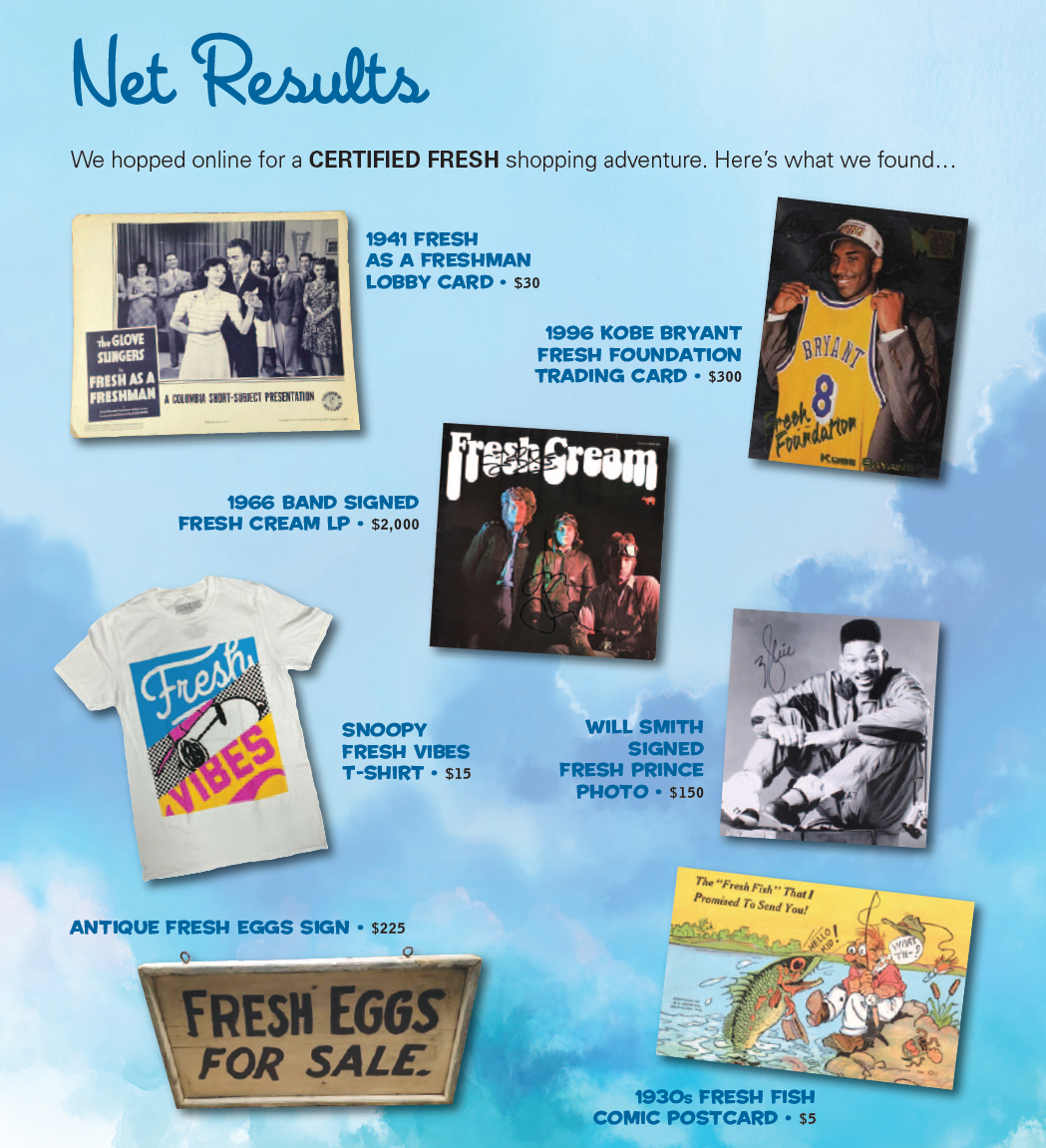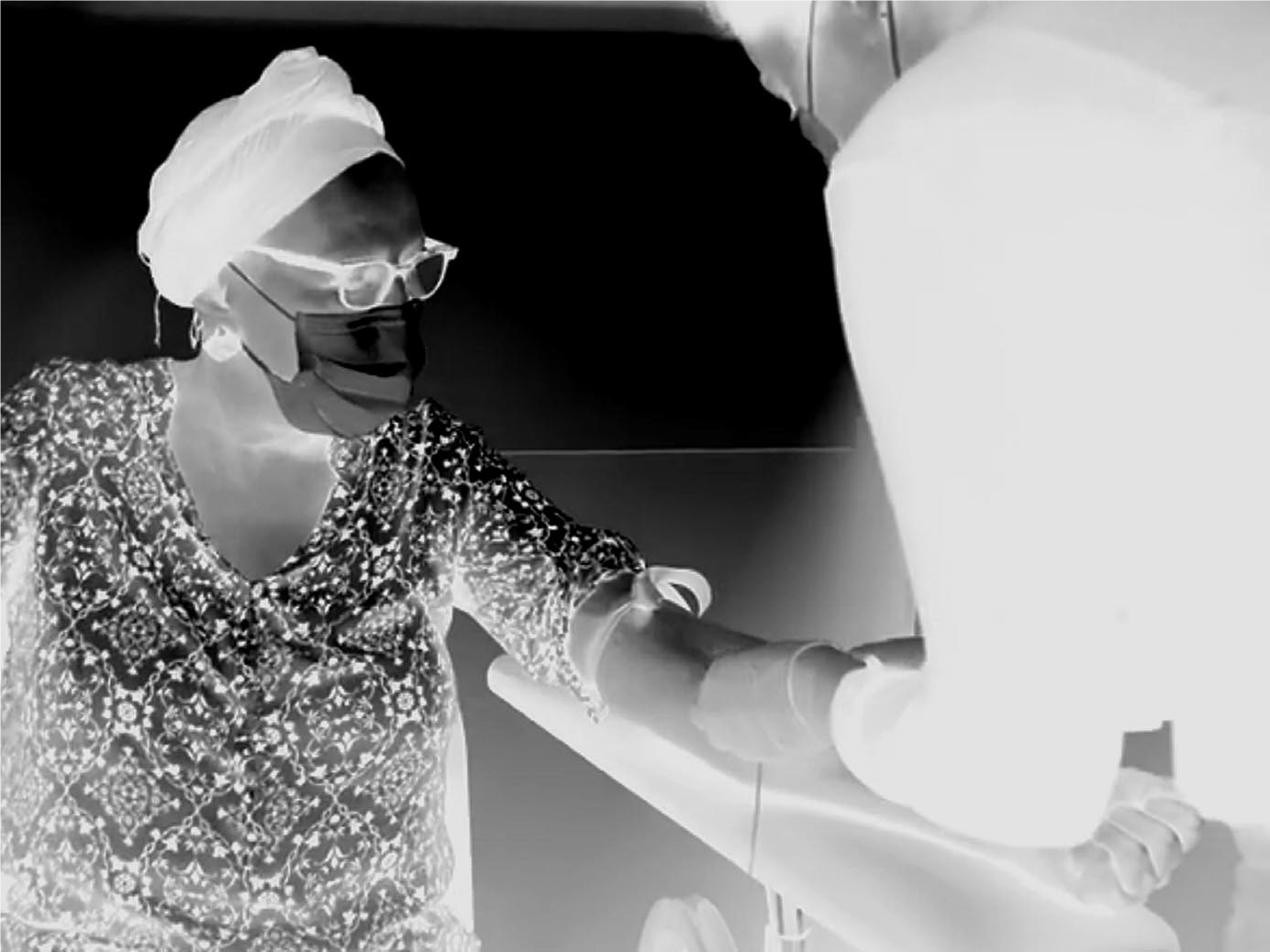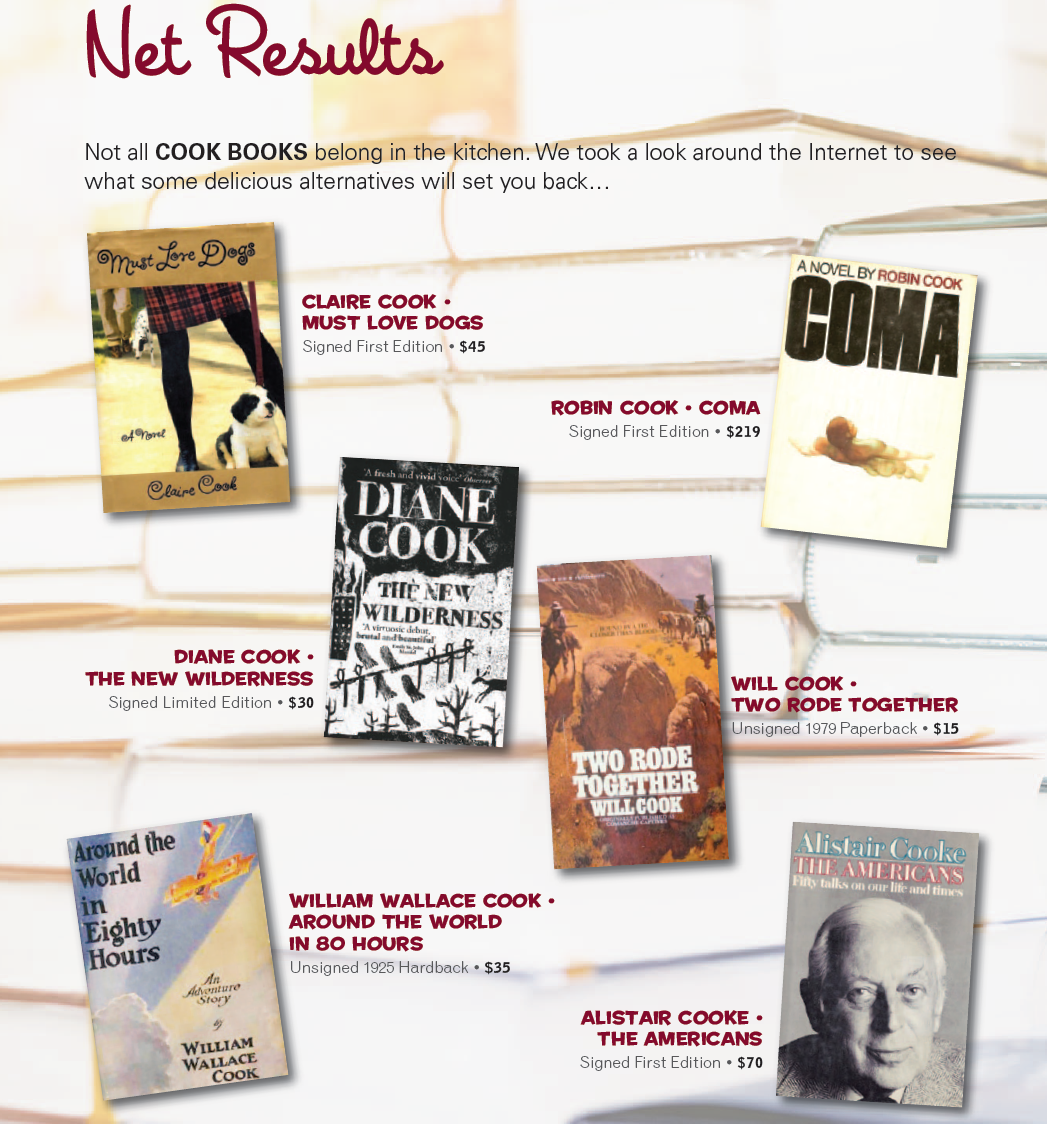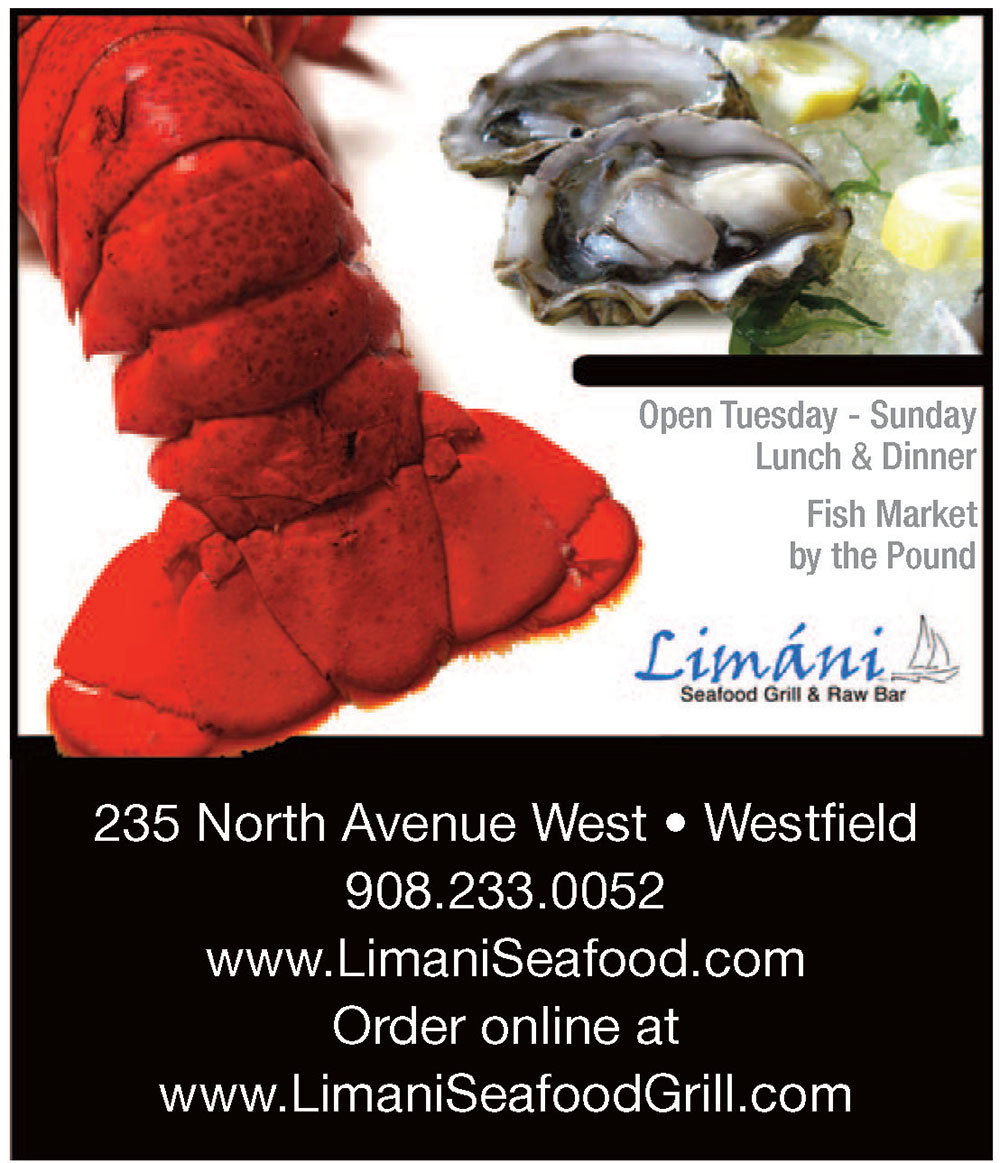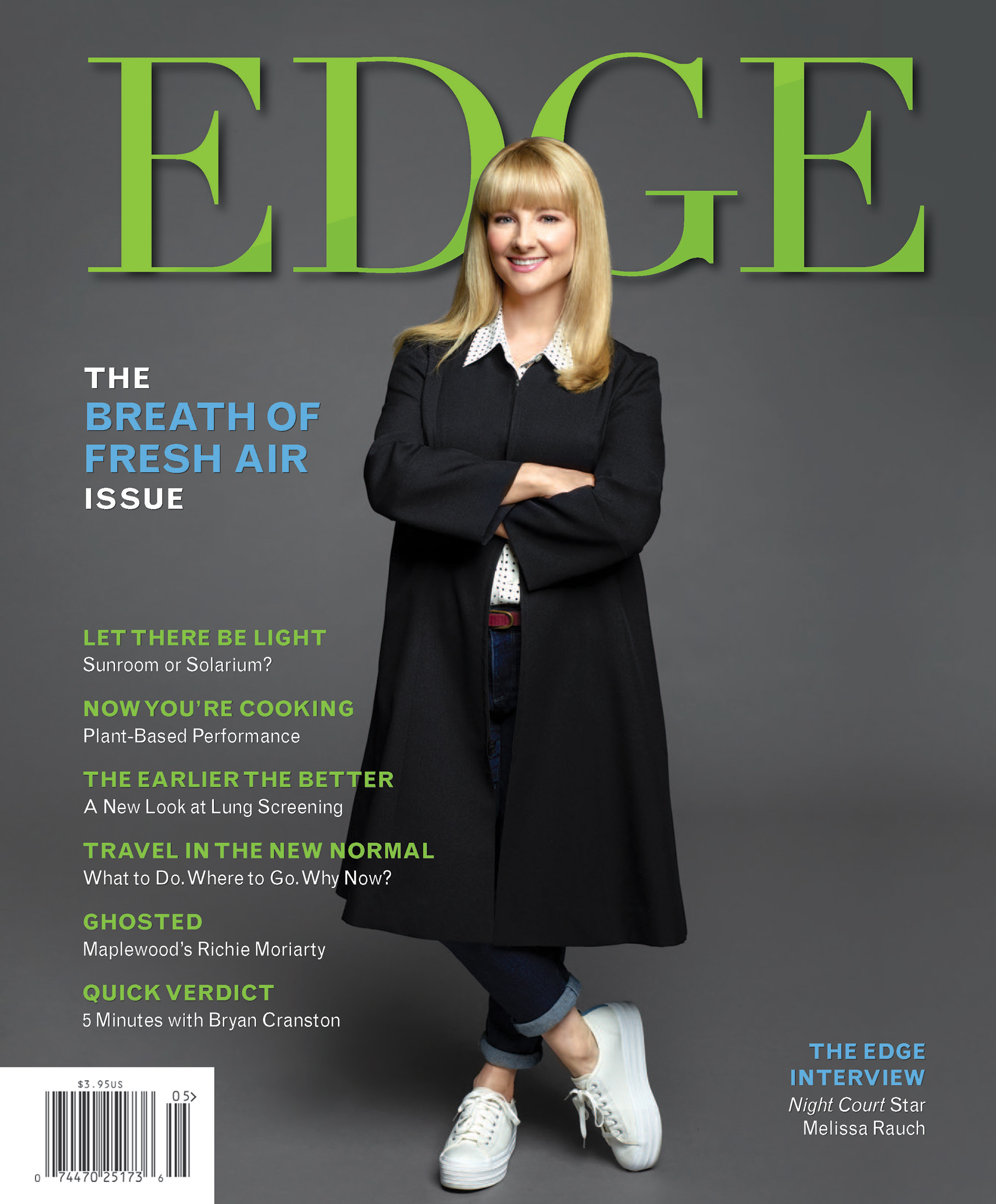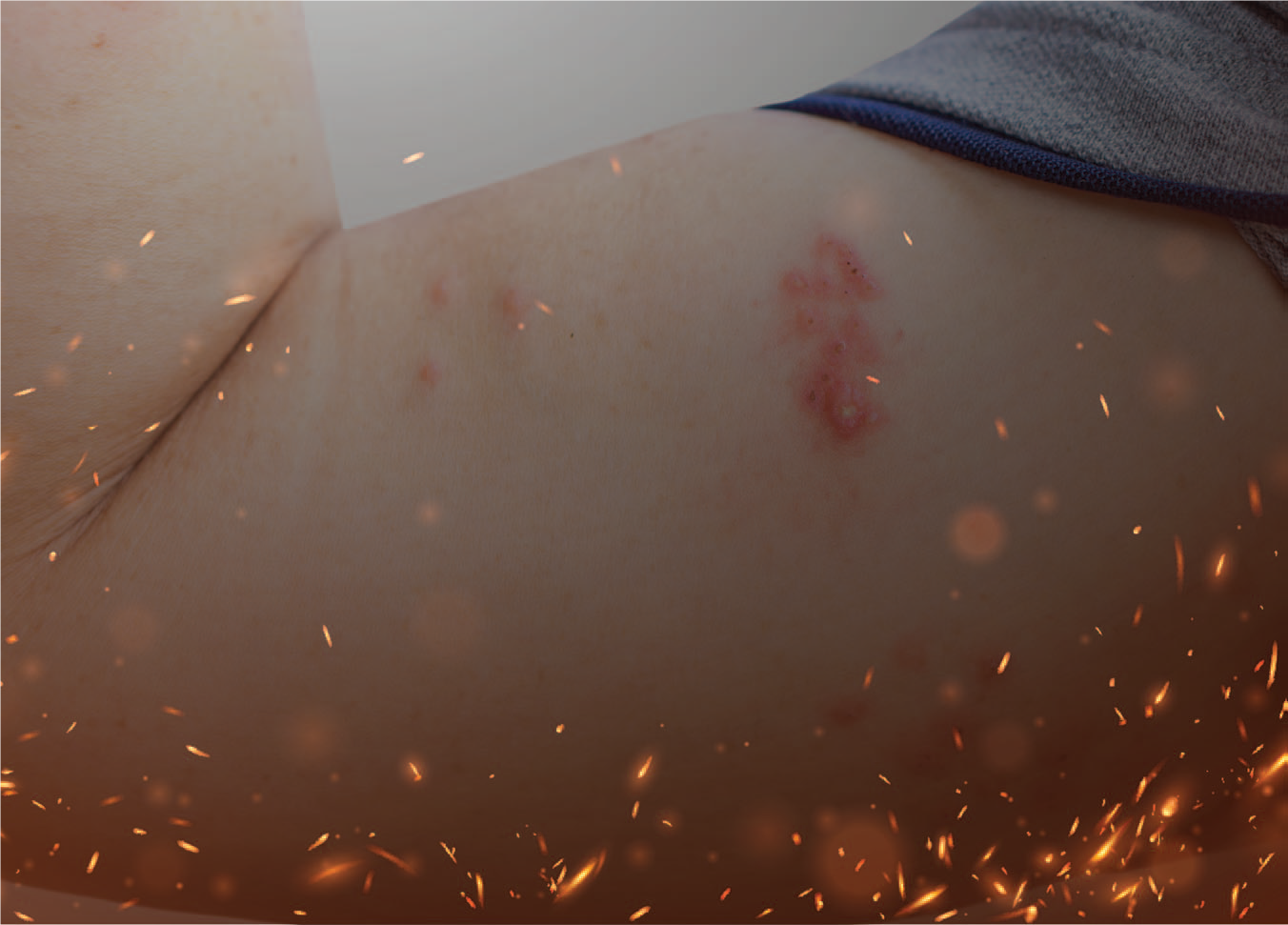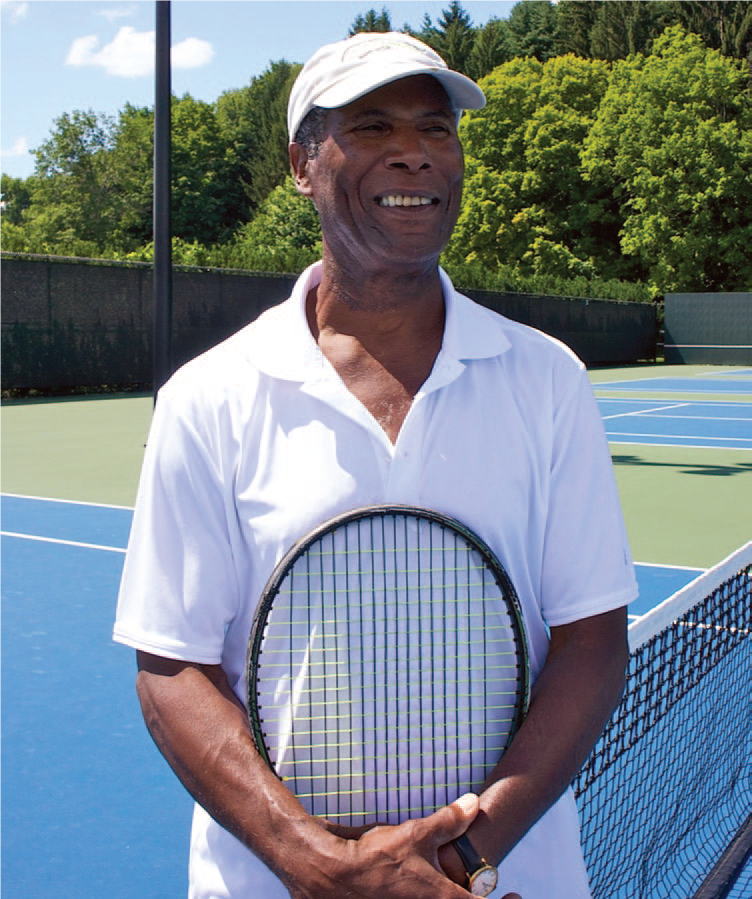Forget about Chinese spy balloons…New Jersey’s relationship with lighter-than-air flight dates back 230 years.

Granger Collection
January 9, 1793
French balloonist Jean-Pierre Blanchard, author of the first-ever balloon flight in Paris in 1784, brought his marvel to America in the winter of 1793. He arranged a demonstration in Philadelphia in front of George Washington and, legend has it, four future presidents: John Adams, Thomas Jefferson, James Madison and James Monroe. Blanchard ascended from the prison yard at the Walnut Street Jail, crossed the Delaware River and overflew Camden before turning south and landing safely in Deptford in Gloucester County, New Jersey. America’s first lighter-than-air flight concluded near the famous Clement Oak, where a plaque commemorated the event before the majestic tree was lost in a storm. Blanchard, who did not speak English, carried a letter from Washington instructing the recipient to deliver the Frenchman and his balloon back to Philadelphia. Which would make it the first air mail flight in the US, as well.
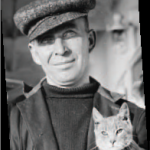
Upper Case Editorial
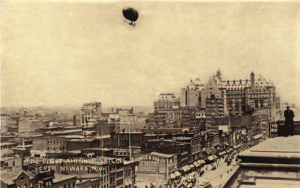
Upper Case Editorial
October 15, 1910
The first attempt to cross the Atlantic Ocean by air lifted off from Atlantic City in the autumn of 1910. The airship America, designed and piloted by Walter Wellman and Melvin Vaniman (left), made its way north, passing over Newark and then continuing northeast up the coast to Maine before heading out over the ocean. Near the end of the journey’s third day, the crew of six (plus Vainman’s cat) had to abort the flight after the motor died, climbing down a rope to a lifeboat before being picked up by a passing steamer. America was originally conceived as a means of flying over the North Pole, but was reconfigured for the transatlantic flight after Robert Peary beat Wellman to it. The airship was 228 feet long and 52 feet in diameter, and was constructed of three layers of silk and cotton fabric, bonded with rubber. Although the 1910 flight lasted just 71 ½ hours, it still set a world record for time aloft.

Upper Case Editorial
July 2, 1912
Undaunted by his failure to cross the ocean in 1910, Melvin Vaniman built a 258-foot airship funded by Goodyear named Akron. The large crowd gathered near the beach in Atlantic City to witness Vaniman’s departure were horrified when, just minutes later, the hydrogen-filled craft exploded, engulfing the gondola in flames as it plunged 2,400 feet into an inlet. Vaniman, his brother Calvin and three crewmembers died in the crash. An investigation determined that the balloon ruptured due to excessive internal pressure—it had been overinflated.

Alexander Cohrs
October 15, 1928
New Jersey served as the port of entry for the first-ever transatlantic commercial passenger air service when the Graf Zeppelin (LZ 127) arrived at the Lakehurst Naval Air Station, in Manchester. The sleek 776-foot rigid airship was named in honor of Count Ferdinand von Zeppelin (Graf is German for Count) and constructed over the course of 18 months by Ludwig Durr. The gondola, which contained the flight deck, 10 passenger cabins, two restrooms and a common area, measured slightly less than 100 feet from end to end. The flight from Germany took 111 hours, 44 minutes and was slowed by a damaged tail fin. While repairs were being completed, a distress call was made but no other radio transmission followed, leading many to believe that airship had fallen into the ocean. On its return flight, the Graf Zeppelin carried Clara Adams, an early aviation celebrity who helped popularize air travel, as well as a stowaway who was discovered hiding in the mail room. The craft was greeted in Germany by President Paul von Hindenberg.

US War Department

US Naval History and Heritage Command
April 4, 1933
What are the odds that two airships named Akron would perish off the coast of New Jersey? Incredibly, that’s just what happened when the US Navy’s Akron—the world’s first flying aircraft carrier—plunged tail-down into the Atlantic in a violent thunderstorm. The resulting 73 deaths made it the worst air disaster in history at the time and the deadliest airship crash ever; only three people survived. A Navy blimp sent out to search for survivors also went into the sea, killing two more men. An investigation determined that virtually all of the Akron deaths had resulted from hypothermia. No lifejackets were issued to the crew, and they were unable to launch lifeboats after the airship hit the water. The accident ended the Navy’s airship experiment, as one of the dead was Rear Admiral William Moffett (left)—among the program’s main proponents.

German Federal Archives
May 6, 1937
The era of airship transportation ended more or less where it began when the Hindenberg exploded as it attempted to land in the early evening at Lakehurst. In 1936, the Hindenberg had completed 10 round trips between Germany and the US without incident, and the May flight was the first of 10 more scheduled for 1937. The airship was only half-full on the flight across the Atlantic, but was fully booked for the return leg of its journey. Many of those passengers were planning to attend the coronation of England’s George VI (of The King’s Speech fame). Poor weather had delayed the flight and prompted Captain Max Pruss to plot a course over Manhattan, stopping traffic and sending office workers racing to catch a glimpse of the craft. He later gave passengers a two-hour “tour” of the Jersey Shore while waiting for the weather to clear. At 7:25 pm, witnesses noticed a blue flame moments before a fire broke out at the rear of the Hindenberg, quickly engulfing the entire airship. The disaster was captured by multiple newsreel cameras and covered live on radio by Herbert Morrison. Of the 97 occupants of the Hindenberg, 62 were able to escape with their lives. Those who perished were badly burned, victims of smoke inhalation or jumped from an excessive height. One member of the ground crew succumbed to his injuries a day later.

German Federal Archives
May 23, 1968
Although the heyday of lighter-than-air aviation had long since passed, Hangar No. 1 at Naval Air Engineering Station Lakehurst, built in 1921, was still in use more than five decades later when it was designated as a National Landmark. The enormous hangar served as home base for four legendary rigid airships—Shenandoah, Los Angeles, Akron and Macon—and was America’s only stopping place for commercial airships (including the Graf Zeppelin and Hindenberg). The hangar measured 996 feet long and was wide enough to accommodate two airships side-by-side. Today, Hangar No. 1 serves as a base for multiple educational programs.
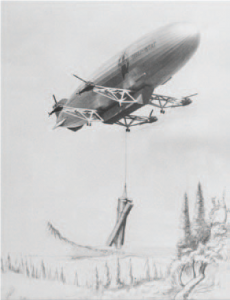
US Dept. of the Interior
April 26, 1986
Everything that flies can only weigh so much before it won’t fly anymore. There is a limit, for instance, to what a blimp can lift. And a limit to what a helicopter can lift. But what about a blimp plus four helicopters? That question was answered in 1986 by the Piasecki PA-p7 Helistat, a helium balloon with four H-34J choppers bolted to it framework. The experimental craft was ordered up by the US Forest Service for harvesting timber from inaccessible terrain. If this sounds a little crazy, well, it was. The craft performed well until a test flight that summer, when a gust of wind moments after liftoff caused one of the helicopters to break free, with its rotor slicing into the gas bag. The ensuing vibration caused the remaining three to break free, sending the Helistat to the ground in what would be its final flight.
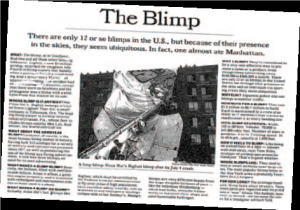
The New York Times Co.
July 4, 1993
The summer of 1993 marked the debut of the 165-foot blimp “Bigfoot,” which was headed for Linden on July 4th when part of its tail assembly came loose and tore a gash in its nylon skin as it traveled down the Hudson River. Strollers along Boulevard East stopped in their tracks to watch the airship—emblazoned with a giant Pizza Hut logo—slowly deflate between New York City and northern Hudson County and veer off toward midtown Manhattan. Bigfoot’s descent came to an end on the side of a building on West 53rd Street. The pilot (a Goodyear veteran of 35 years) and his co-pilot, were lucky to walk away with minor injuries. New York Mayor David Dinkins, who was often out of town when weird things happened in the city, was scheduled to fly to Israel that evening. After surveying the scene, he joked, “The first thought I had was, man, I haven’t even gotten on a plane yet!”
EDGE Interview

Jonathan Wenk / CBS
If Richie Moriarty strikes you as one of those performers you swear you’ve seen everywhere, there is a reason…he is. The veteran actor’s résumé includes roles on House of Cards, Unbreakable Kimmy Schmidt, Orange Is the New Black, Adam Ruins Everything, The Tick, Power and What We Do in the Shadows—as well as an unforgettable 2019 Super Bowl teaser with John Malkovich and Peyton Manning. Richie is at his best when he is part of a quirky cast and, currently, he co-stars in the CBS series Ghosts, the top-rated new network comedy in 2022. Although he is a master at blending in, his character in Ghosts is impossible to miss: deceased scoutmaster Pete, best friend of the series lead, who roams the earth as he died, with an arrow through his neck. Recently, residents of a certain Essex County enclave have spotted Richie, sans arrow, roaming their streets. Gerry Strauss wanted to find out why.
EDGE: What brought you to Maplewood?
RM: My wife and I met in Brooklyn and we were starting to raise our son there. Right around when he started crawling and getting mobile, we were like, “Oh, we can’t do this in our tiny one-bedroom apartment in Brooklyn.” So we started to chat with people about where people go. You know, where can we go to actually afford a place to live—but still be close enough to the city where we can both commute? The towns of Maplewood and South Orange just kept coming up as great commuter towns on the train line, 30 minutes roughly into Penn Station. It’s hard to beat. In Jersey, we could afford a multi-bedroom house as opposed to the terrible one-bedroom that we could afford in Brooklyn with that same money. My wife and I took our baby son out on the train to Maplewood, did a little 12-hour tour of the area and really fell in love with it very quickly, and started looking for houses very soon after that. I feel so fortunate that we got here in 2018 before the explosion of home prices. We’ve just really loved our time in Maplewood. It’s a really great place for us to be.
EDGE: The blend of offbeat humor and genuine heart in Ghosts won over audiences quickly. What’s been the secret to maintaining that balance?
RM: Our writers and showrunners have done such an incredible job with that balance. I do think it is what makes the show special—and is exceedingly difficult to do well. It never feels forced and always has this tone where you can be laughing one second and brought to tears the next moment. A lot of that comes from the audience’s connection to the characters on the show. Everyone has done a masterful job of inhabiting these characters and bringing a fullness to them. It’s hard for a guy with an arrow sticking out of his neck to not feel like a cartoon, but the writing has been so great that it’s given us all backstories, and it’s made the audience feel a real connection with us, which really helps in selling those more emotional moments.
EDGE: In many respects, Ghosts is the ultimate ensemble comedy, not only because there are so many of you, but you are also often all performing in a small space within a house. What’s the secret to creating the right chemistry among such a large and talented cast?
RM: You know, I tell everybody who asks about the show how lucky I am to be a part of this particular group of people. The entire cast has all become close friends of mine, and I feel so fortunate to be doing this job with these people. Honestly, part of what I think contributes to what you’re talking about is the way that we started this show. We were all cast in February or March of 2020, and then the world shut down. I was actually flown from Jersey to LA to shoot the pilot and during Day Two of pre-production, when we were finalizing wardrobe and props and all that stuff, we were shut down and sent home. We all really thought that this opportunity was going to disappear, because a lot of shows over that next six months were released from networks because nobody knew what the future of filming was going to look like in the world of COVID. So from March to December, the cast had this crazy window where we had no idea if this opportunity was going to disappear, if we were ever going to get to do this thing together. Over the course of those seven or eight months, we were on constant text chains with each other. We were Zooming all the time just to check in with each other because we felt like we were on this weird island where we still had this great opportunity that was coming down the road, but we didn’t know if it was going to disappear. I think it really bonded us in a special way. By the time we finally did shoot that pilot eight months later, we all felt like we were so much closer than we would’ve been had we shot in March. We were just so excited about finally getting this opportunity to do this thing together. We’re so fortunate that it was actually picked up to series and we got to make the series, but I think that has a lot to do with the chemistry that you see on screen. We were unified in a very bizarre way during the pandemic, and by the time we got together we felt like we were friends, you know?
EDGE: What do you enjoy most about playing Pete?
RM: I think the main difference between Pete and myself is his eternal optimism. I mean, the amount of cheeriness and optimism this guy has—I wish I had 10% of it [laughs]. It’s really fun to step into those shoes and view the world through a lens that I don’t typically view the world through. There’s something really special, too, about the fact that all of our characters are period-specific. The 1980’s is when I grew up, and I very much feel like this character is my dad in a lot of ways. He was roughly the age that Pete was in 1985 when he died.
EDGE: Pete’s backstory is deeply emotional. Does that hit home for you?
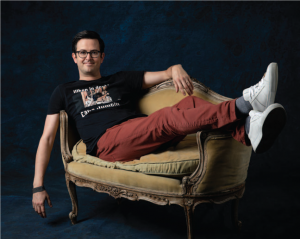
Sarah Coulyer / Paramount+
RM: For sure. When we filmed the “Pete’s Wife” episode—where his daughter and grandson, who Pete didn’t know even existed, show up, my wife had just given birth to our daughter. She was six weeks old when we moved to Montreal for six months to film the first season. Of course, everyone is very raw emotionally when they have a newborn [laughs]. You’re low on sleep and you’re falling in love with this brand-new human. That made it very easy for me to tap into the emotion of what that would mean to see your adult daughter for the first time and then get the news that you have a grandson, and that your legacy and your family is living on.
EDGE: Your résumé is full of amazing scripted performances, but you also have a deep improvisational background. Which style of performing do you prefer?
RM: I definitely prefer improvising. There’s something magical about improv. There’s also something lovely about not having to memorize lines [laughs]. I’ve been improvising for more than a decade now. I started in 2008 or so, and I love it.
EDGE: Is there room for improv in Ghosts?
RM: The mantra in improv is to have each other’s back and to support your scene partners, and that comes into play all the time on this show. You’re always looking for opportunities to amplify other people’s voices or see opportunities for them to make the scene stronger. There’s this team mentality, because you’re creating this thing together. In terms of improvising on set, it’s always a little bit director-specific. Some directors come in and love to find opportunities that aren’t on the page to punch the script up and make it better, but the scripts come in so tight and so funny already that we don’t have a ton of leeway. Really, the opportunities are the button of a scene—the final line in a scene can sometimes be an opportunity to throw in a very quick improvised moment. God knows, we try to do a lot more than that, but those moments often end up on the cutting-room floor because there just isn’t a ton of time in a network sitcom to play like that.
EDGE: Time to spill a trade secret. Your character Pete was killed by an arrow that was accidentally shot through his neck, and his ghost is destined to be stuck with that arrow for all of eternity. Is that thing a clip-on, or does it involve hours of make-up and glue to attach it to you every day you are shooting?
RM: Luckily, they have made it very fast. We were tinkering with it a lot during Season One to try to get it to maintain a certain angle all the time so that it looks consistent, and it’s tricky to do. One of the people that works in wardrobe is a woman named Julie. She’s in charge of my arrow specifically, so before every take she’s making sure that thing is set perfectly. There’s a metal bracket that fits behind my neck and it has two screws—one on each side—and so the ends of the arrows just screw on. Wow [laughs]. They tuck that metal bracket in my scarf and then they puncture two holes through the scarf so both ends of the arrow can be screwed in. It’s pretty quick, easy on and off.
Editor’s Note: Ghosts airs Thursday nights on CBS and was just renewed for a third season.
The science and history of overpowering odor.

Reckitt Benckiser Group
In 2023, the global market for air fresheners will surpass $12 billion. According to Precedence Research, a company that provides investors with strategic market insights, that number will likely double by 2030. Does that mean the world is smelling progressively worse, or that humans are becoming more sensitive to unpleasant odors? The answer is both and none of the above. Think of all the clean, lovely homes of your friends and neighbors in suburban New Jersey. Some have an air freshener diffuser in almost every room, while others have none. Does one home smell noticeably “better” than the other? Probably not.
The use of air fresheners is a matter of personal taste and personal choice. Some folks can’t live with them, others can’t live without them. Some folks are severely allergic to strong, artificial scents. Others cannot enter the average teenager’s bedroom without a finger on the trigger of a can of Febreze, ready to fire, like an Old West gunslinger, at a week-old sweat sock or unchanged bottom sheet.

NC Museum of Art
Although it differs from country to country and culture to culture, the use of air fresheners is almost always linked to the concern that others will judge you through their nostrils. Madison Avenue has masterfully leveraged this paranoia into a global growth industry. After all, who among us doesn’t wonder whether our home or business or vehicle could smell a little better and, by extension, how that might elevate us in the eyes of others? One also wonders whether the air freshener industry created the “thick air” market out of thin air, or whether it tapped into something that is actually baked into our DNA. How far back does the need to make a positive aromatic impression stretch? Imagine the first modern human entering a Neanderthal cave—did he (or, let’s face it, she) wonder, “What’s wrong with these people?”
Air fresheners as we know them first appeared on supermarket shelves around 1950. Like a lot of breakthrough consumer items during this era, the technology had its roots in military applications developed during World War II. Put a pin in that for a moment and let’s turn back the clock to the original concept of odor-masking.
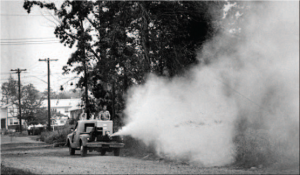
SILive

Reckitt Benckiser Group
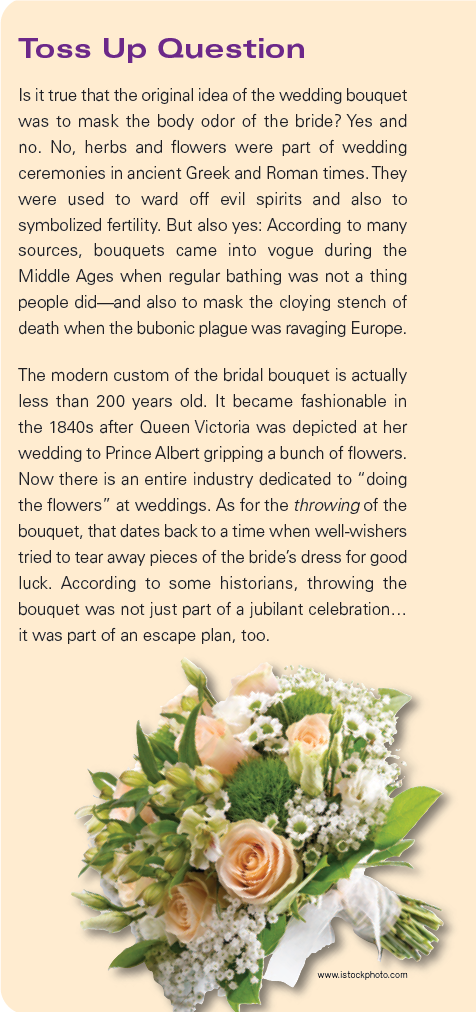
www.istockphoto.com
It is a practice that dates back several thousand years, most likely to at least the Bronze Age and perhaps beyond. In ancient cultures, priests and other religious leaders burned animal parts as sacrificial offerings to the gods. In interior spaces, the smell must have been unbearable, so various herbs and aromatic plants would have been burned at the same time. We know this because the Latin root of the word perfume, per fumus, means “through smoke.” There are records of the ancient Egyptians using scented oils on their bodies and textiles, and the extraction of air-freshening oils was being done on a commercial level in Mesopotamia more than 3,000 years ago.
Fast-forward to the 8th and 9th centuries and we find the discovery of steam distillation in the Islamic world. Suddenly, odor-masking scents were widely available; they were even mixed into the mortar used in the construction of mosques. The popular use of perfumes and other exotic scents in the West was accelerated by the Crusades, when Europeans who survived their adventures in the Eastern Mediterranean brought back sweet-smelling souvenirs from the markets of the Holy Land. Perfume production really kicked into high gear during the Renaissance. Hungary, of all places, became an important center of production. And of course, the French became famous consumers of perfumes and scented oils. You may recall from a long-ago history class that King Louis XIV was called the “Sun King.”
What they probably didn’t teach you was that his great-grandson, Louis XV (left)—who succeeded him as a boy in the early 1700s—was known for soaking everything in his palace with a different scent every day. The young monarch’s court was known as “La Cours Parfumée.” The science behind air fresheners may have changed since the “Louies” but the basic concept hasn’t: Find something that smells better than the odor you’re trying to mask, and then keep it hanging in the air as long as possible.
So back to the 1950s. The US military found a clever way to do this, using sophisticated chemistry that had the ability to eliminate and replace odors with a fine, pleasant-smelling mist. The original use for this technology was in pesticides that were used in close proximity to humans. Children of the postwar era may recall the “mosquito trucks” (below) that rolled through suburban neighborhoods puffing out sweet-smelling DDT.

Procter & Gamble/Febreze
Soon, few respectable American homes were without a can of name-brand air freshener to kill bathroom, cooking and pet odors. Lysol and Air Wick were already recognized household brands before the age of aerosol sprays. Glade arrived in the mid-1950s, accompanied by a catchy jingle and the polite suggestion that you buy a second can for the “medicine cabinet” (bathroom) to make indoor air “smell as fresh as all outdoors”. These products (and the different scents they developed) became ubiquitous outside of homes, as well—in hotel rooms, restaurants, theaters, doctor’s and dentist’s offices, and automobile showrooms. The chemicals that enabled these products to eliminate odors instead of merely overpowering them included Pre-Polymers, Ester, and Long-Chain Aldehydes. Feel free to look them up but don’t expect to understand a thing about them.
What most people do understand, however, is that the leading air freshener brands back then weren’t exactly healthy. In the 1970s and 1980s, the air freshener market faced a crisis when it was determined that the Chlorofluorocarbons (CFCs) that powered them also harmed earth’s ozone layer. Also, reports of negative side-effects on asthma sufferers—and the possible impact on reproductive chemistry—accompanied the additional bad news that these products contained low levels of carcinogenic material.
A range of alternatives arrived on the market, including scented candles, heated oils and gels, and solid gels. Febreze, which has been around since the late-1990s, grabbed a huge portion of the market share thanks to spot-on ad campaigns (had you ever heard of “Nose Blind” before Febreze?) and its use of Hydroxypropyl Beta-Cyclodextrin, a molecule derived from corn cobs that traps and binds malodorous molecules and reduces their scent. It is meant to be sprayed on fabric as opposed to being waved in the air like a magic wand.

Etsy
So, is there anything new in the air freshener world? Glad you asked. The old-school tree freshener (aka Little Tree) appears to have found a fascinating second life. The cardboard pine trees that used to hang from rearview mirrors now come in a variety of shapes and smells, most notably as the disembodied heads of celebrities. These aren’t your grandfather’s tree fresheners, the ones you could pick up for pocket change at the local service station. They are typically unlicensed homemade “art” products and they sell like crazy for $5 to $15 on web sites like Etsy. Want a Taylor Swift? Done. Tupac? Done. You can even send in a family photo to make a customized tree freshener. There’s a good chance your spouse and children have never smelled better.
I was in an Uber recently that had an unshaven Jonah Hill air freshener dangling over the dashboard so, yes, there is almost certainly some irony involved, too.
Or maybe the driver was just a big Jonah Hill fan.
10 Questions About Bad Breath
Call it halitosis, call it oral malodor, call it morning breath—call it whatever you want—but bad breath by any name is big business. The mouthwash and breath freshener industry will generate between $6 and $7 billion this year…because no one wants to see the look on someone’s face when we gas them out.
What causes bad breath?
Typically, but not always, halitosis begins in the mouth. Common causes include poor dental hygiene, xerostomia (aka “dry mouth”), certain foods and spices, tobacco use, some medications, and infections from sores, gum disease or oral surgery. Acid reflux, certain diseases (including some cancers) and metabolic disorders can also cause bad breath. Your tongue harbors odor-causing bacteria, too.
Why do I have bad breath after eating garlic?
After digesting certain foods, including garlic and onions, they can enter your bloodstream and find their way into your lungs, which can affect your breath.
What’s the story behind halitosis?
It is as old as human history. Ancient people boiled herbs and spices to create chewable “breath mints” so we know halitosis had been a concern for thousands of years. Indeed, Halitosis is actually Latin for “diseased breath.” The late-1800s saw the manufacture of the first mouthwash, Listerine, which was named in honor of Dr. Joseph Lister, a pioneer in antiseptic surgery. However, it didn’t catch on with the public until the 1920s, when Listerine began claiming it could “Cure Halitosis”—which sounded more like a serious medical condition than bad breath.
How did bad breath become such big business?
“Often a bridesmaid but never a bride.” That was Poor Edna, the “star” of Listerine’s most successful ad campaign. Everything about her was desirable…except her halitosis. Thanks to Edna, by the end of the 1920s, annual sales rose from $100,000 to $4 million—a forty-fold increase. During the 1940s and ’50s, Chlorophyll offered a less medicine-y option and made Clorets one of the world’s top selling breath fresheners. Readers of a certain age may remember the brilliant 1960s marketing campaign behind Scope, the minty mouthwash that went head-to-head with Listerine. The best way to let someone know they had bad breath was to leave a bottle in the mailbox with a note: Once in the morning does it! Signed The Green Phantom. More recently, Tic Tacs became the go-to solution for halitosis.

www.istockphoto.com
Does mouthwash do any good?
That depends…because there are two types of mouthwash: Cosmetic and Therapeutic. Cosmetic products control bad breath and leave a sweet or minty taste in your mouth, but don’t provide any long-term benefit because they don’t kill odor-causing bacteria. Of course, that may be all you need if you just had raw onions on your burger or some fish sauce with your Thai food. Therapeutic rinses—which are sold over the counter and are also prescription products—contain active ingredients that reduce the causes of bad breath.
What are the main foods that cause bad breath?
According to the good folks at Listerine, the “Top 5” foods that cause bad breath are 1) Garlic 2) Onions 3) Dairy 4) Canned Tuna 5) Horseradish. Yes, horseradish. Its strong, eye-watering smell—which is created by the organosulfur compound allyl isothiocyanate—can trigger halitosis. That’s no surprise, considering its purpose in nature is to drive off hungry herbivores.
Wait. Why do dairy products cause bad breath?
Because the bacteria that lives on your tongue actually feeds on the amino acids in milk and cheese, creating an unpleasant odor.
Is bad breath a sign of something more serious?
It can be. Bad breath often accompanies dental infections and acid reflux (aka GERD). A metallic odor or fruity taste are also signs that should trigger concern.

www.istockphoto.com
Can bad breath also be “good” breath? Is that a dumb question?
First of all, that’s two questions. However, there is nothing dumb about it. In the sense that it may provide early clues to major health issues, bad breath can indeed be a “positive.” Studies have been conducted over the last decade that hold great promise in the detection of lung cancer and cardiovascular issues, including heart failure. Don’t be surprised if, one day, “breath tests” replace invasive procedures as a first line of detection.
Which foods naturally fight bad breath?
Gingerol-6, the chemical in ginger, helps break down sulfur compounds, so chewing on ginger or drinking ginger tea (or ale) can help. Cherries can neutralize methyl mercaptan, the gas produced by mouth bacteria that smells like old cabbage. So can lettuce. Cinnamon contains an essential oil with antimicrobial and antiseptic properties, so pop a cinnamon Altoid or chew on a cinnamon stick. The vitamin C in oranges and other citrus fruits can help control bacterial activity in your mouth and neutralize unpleasant odors. Fresh spinach is high in zinc, which prevents the build-up of sulfur compounds.
Bonus Question
How do I know if I have bad breath?
Ask someone you know and trust. Smelling your own breath is a lot like taking your temperature by putting your hand on your forehead. It doesn’t really work.
Through years of strife, controversy and world-shaking events, artist and illustrator Norman Rockwell benevolently depicted the core of average American life and the American dream. Starting in 1916, the covers he made for The Saturday Evening Post and other publications created an important chronological history of American homespun sensibility. Ed Gabel’s drawings and paintings, many on the covers of Time and several other magazines, do a similar job but with a more editorial point of view of national and global issues. Nothing average, nothing soft or nostalgic. Gabel tackles current events with a keen eye for the ironic. He juxtaposes and blends unlikely images to accompany a magazine’s cover story. Gabel spotlights thorny issues with astounding, opinionated realism. He astutely represents the illustration evolution—from Rockwell’s tender, moving and often amusing observations to Gabel’s punch of emotionally and critically charged issues painted with a most determined brush.

Time USA
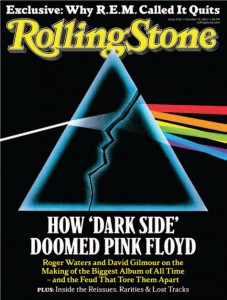
Time USA

Time USA

Time USA

Time USA

Time USA

Time USA

Time USA
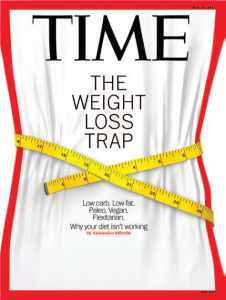
Time USA
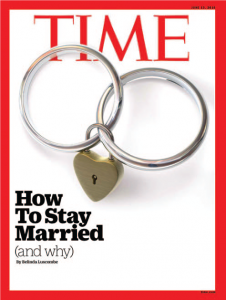
Time USA
About the Artist
Ed Gabel has more than 25 years’ experience in the publishing industry and specializes in illustration and animation. Born in 1964 in Ohio and a graduate of Miami University (Oxford, OH), he began his career as an artist for newspapers, including the Asbury Park Press and the Toledo Blade, which led to a position at TIME magazine where he worked for nine years. He currently co-owns a design studio, Brobel Design, located in Westfield. “I was influenced early on by newspaper comic strips and the drawing style of MAD magazine. In the 1990s, I began to focus on 3D computer illustration inspired by the groundbreaking style of Pixar Studios,” says Gabel. His illustrations have appeared on the covers of TIME, Newsweek, and Rolling Stone, among others. He has also created artwork used by Major League Baseball, the National Hockey League, DC Comics, and ESPN. He lives in Cranford and spends his free time riding throughout the northeast on his Harley Davidson.
What went wrong in 2022. How it’s looking in 2023.
Air travel showed us its bad side last year. Last holiday season, Southwest canceled 16,700 flights, losing more than a billion dollars in revenue through lost ticket sales and reimbursements, and tarnishing their very bronze reputation as the cheap airline that isn’t as bad as Spirit. Reasons why piled up, most having to do with logistics, software and payroll. To be a bit reductive, Southwest is the kind of company that “runs lean and hot”—cutting costs where it really shouldn’t to find profits on the low end.

www.istockphoto.com
For an even simpler explanation, we could turn to Southwest’s own Twitter page, on which the airline’s CEO, Bob Jordan, released an apology video wherein he referred to Southwest’s ongoing operation as a “giant puzzle.”
Unfortunately, it’s the kind of puzzle where thousands of people sleep on the floor with backpacks as pillows—while hundreds of pilots and flight coordinators try to assemble the pieces using Skysolver, a scheduling software from the 1990s that tends to glitch up when the weather gets bad, forcing crew members to call each other over the phone and hash it out that way.
Also during the 2022 holiday season, a pair of Australian baggage handlers were sacked for mishandling baggage. In a word, they were slamming suitcases down onto a conveyor belt. Two more words: punting and shot-putting. Really, they were fired for getting caught on a camera they’d presumably aimed at themselves. Their movie, uploaded to TikTok and recirculated by news outlets, frames the pair of handlers, giggling in high-vis jackets under the nauseating glow of industrial lighting, with a can of Red Bull in the foreground. Not the nicest workplace, but you have to hope no one was flying with heirloom china. You also have to imagine this kind of smackdown happens in the backrooms of airports all the time when the cameras aren’t rolling.
Holiday ’22 felt like a peephole into the peptic inner works of the travel industry. Stress, incompetence and the convolution of air travel were laid bare after a two-year partial hiatus from full-capacity operation. Were these snafus a fluke of gearing back up, a little hiccup in the grand scheme, or do you and your family have more to worry about if you’re planning to travel in the second half of 2023?

The Big 3
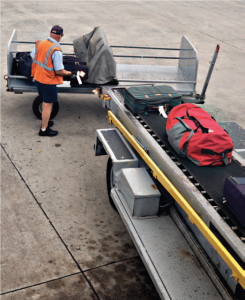
www.istockphoto.com
If you’re flying for vacation and care most about peace of mind, it makes sense to pay Delta’s rate, which is uniformly more than the budget option. Delta ranks well on cancellations, on-time arrivals and mishandled baggage: three issues likely to ruin or complicate your family’s vacation plans. United does fine as well, and generally outperforms American—though not in every category—so it comes down to whether you’d rather lose your bags or your sanity sitting motionless on the tarmac when choosing between these Big 3. If you’re flying to Hawaii, even better because Hawaiian Airlines is actually the best one, but it only goes there. Alaskan Airlines is also fantastic, but it runs fewer planes.
These performance metrics are eclipsed, in my opinion, by the general robustness built into the Big 3 airlines. United, Delta and American have a tacit agreement to exchange canceled flights between companies, basically allowing a traveler to hop from one airline to another frictionlessly when it’s the airline’s fault. This is inside baseball; these standing contracts between airlines are expensive, however, and Southwest predictably cheaped out.
Understand that Southwest (and other budget airlines) fly point-to-point, meaning their planes can shoot straight from one minor airport to another. This lets passengers fly from Atlantic City to Orlando without a layover, but it also means that, if your plane isn’t at Atlantic City when you are, or if your plane looks a little too dinged up for airfare, you’re stuck until the company sends you another one, perhaps from very far away. Who knows? If it’s Southwest (which, for the record, does not service AC), chances are they’re figuring it out on the phone and maybe you should get a hotel. It is point-to-point in all its glory.

www.istockphoto.com
The hub-and-spoke model used by Delta, United and American forces minor airports to link up at big hub ones, like Pittsburgh or O’Hare. That can be an annoyance in the form of a layover, but these hub airports are heavily staffed with redundant pilots, flight coordinators and attendants. If a plane or crew aren’t feeling up to it, it’s much simpler to shuffle in another set of key pieces, keeping things chugging along just fine. Airlines using hub-and-spoke are an even better deal if you’re flying from one hub to another, say Newark to Miami, in which case you get all the security from their inbuilt redundancy without the downtime of a layover, which is at least the evil you know.

www.istockphoto.com
Until jetpacks get much better, we’re at the mercy of these airlines. It’s all about trusting a company well enough to handle you and some or all your belongings cleverly enough to, say, cover the 2,752 westward miles between Newark and San Diego without a major hassle. That kind of ticket from most major airlines comes with the expectation you’ll arrive intact, albeit with your stomach annoyed by the time zone differential, your brain a little foggy, and your knees rubbed a bit raw from five-hours’ brushing contact with the seat ahead of you if, like me, you’re tall and fly coach. Not too bad considering that’s seven percent of the time an identical trip would take you on a Greyhound. The good news is that, as we head into the summer travel season and begin steeling ourselves for whatever lies ahead between Thanksgiving and New Year’s Day, it’s looking safe and easy to board a flight or book a cruise. I wouldn’t even worry about Southwest, at least until Christmas. They’re reeling from a punch in the nose, but barring the kind of snowstorms and demand brought on by the holidays, their point-to-point model is an alright way to shave a few dollars off the price of airfare, especially if your travel plans include a non-major airport. It almost always works.
It’s just that, when it doesn’t, you’re forced to think about why. You trace the line from pilot to engine to plane to tarmac and realize what a “giant puzzle” it really all is.
Also, don’t worry about Southwest CEO Bob Jordan. He likes to fly first class on American.
Age eligibility for lung cancer screening is lowered by five years.
One of the many overlooked medical stories during the COVID-19 pandemic was an announcement by the US Preventative Services Task Force (USPTF) that it had expanded the eligibility guidelines for lung screening. The decision came in March 2021, a year into the pandemic and, somewhat ironically, flew under the radar at a time when we were all hyper-focused on the health of our lungs.

www.istockphoto.com
The USPTF tweaked its 2013 recommendation, which had encouraged people 55 to 80 with a 30-year pack history of smoking (or current smokers) to undergo annual screenings. The new recommendation now includes adults 50 to 80 with a 20-year pack history who are either current smokers or who had quit within the past 15 years. The 2021 USPTF also suggested that screenings be discontinued once a person has not smoked for 15 years—or has developed a health problem that substantially limits life expectancy or the ability/willingness to have curative lung surgery.
The expanded eligibility is, in part, a result of reviewing evidence from clinical trials that screening with low-dose computed tomography (LDCT) provides benefit in younger patients and patients with lighter smoking histories. LDCT is an established safe technology that is more accurate than traditional x-rays for lung cancer screening. According to Dr. Albert C. Li, an Interventional Radiologist at Trinitas, the evidence supports the wider age range and there is clearly “value.” Medicare agrees with the increased value, as it announced expansion of coverage for lung cancer screening with LDCT for eligible Medicare beneficiaries.
“If you screen patients in the new range, you will save more lives,” says Dr. Li. “In eligible patients, low-dose CT for lung cancer screening should be performed once a year.”

The lowering of the age recommendation to 50 differs from other health organization—including the American Cancer Society, National Comprehensive Cancer Network and American Association of Thoracic Surgery—all of which currently are at 55.

www.istockphoto.com
Earlier screening, of course, increases the chances of earlier detection and treatment—and a greater chance for cure. Currently, nearly 80% of patients who present with lung cancer are already at the point where it has spread to nearby lymph nodes or, worse, metastasized to other parts of the body. Metastasized lung cancer has a five-year survival rate in the single digits.
When lung cancer is diagnosed while it is still a localized disease, survival rates soar well over 50%. The problem is that lung cancer is caught that early in only 17% of people. Dr. Li wants to see that number increase through early detection via participation in a lung screening program, such as the program that exists at Trinitas.
“That will happen through patient education, as well as reaching out to primary care doctors to remind them that lung screening eligibility has expanded,” he says. “If you are reading this and meet the criteria, talk to your doctor about getting screened.”
 As with any screening test, there are risks and benefits, Dr. Li adds.
As with any screening test, there are risks and benefits, Dr. Li adds.
“However, there is good evidence that lung cancer screening will give a moderate net benefit for our patients with increased risk.”
Editor’s Note: Dr. Albert C. Li is an Interventional Radiologist at Trinitas. He received his medical degree from Rutgers New Jersey Medical School and has been in practice for more than 20 years. For LDCT screening appointments, call (732) 955-8825. University Radiology at Trinitas is located at 415 Morris Avenue in Elizabeth.
An ailing photographer provides a snapshot of the integrated care experience at Trinitas.

Trinitas Regional Medical Center
In 2020, Brazilian photographer Sonia Braga came to New Jersey to help care for her daughter and grandson. She had been diagnosed with cancer in her home country, for which she had received treatment and believed she was cured. Unfortunately, prior to her arrival in the US, the cancer had returned and had metastasized. Braga transferred her care to Trinitas, and informed her medical team that she had also been diagnosed with depression, starting at the age of 11. Over the course of many decades, Braga had seen numerous doctors who prescribed different medications, all of which had unpleasant side effects.
“When I met Sonia, her journey was already a long journey and the first thing that struck me was that it was taking a huge toll on her, not only physically but mentally,” says Dr. Michelle Cholankeril (above), the hospital’s Division Chief of Medical Oncology. “I felt that it might be beneficial to send her for a wellness checkup, because it’s really important that the medications we give in oncological services work well with the medications that are used for psychiatric illness.”

Trinitas Regional Medical Center
In a traditional model of healthcare, patient experience is often siloed into different pieces. In a case like Braga’s, for instance, it would probably involve finding a medical provider to address her physical symptoms and then going out and identifying a behavioral health provider to talk about the mental side of the equation—and then coping with the added challenge of cobbling all the various pieces together.
“What we do at Trinitas is offer an integrated-care experience that relieves the patient of the burden of having to try to navigate a system themselves,” explains Lisa Dressner, VP of Behavioral Health, who adds that this approach “provides the best possible outcomes for our patients.”
Braga enrolled in an eight-week outpatient program that looked at the entirety of her treatment and prescribed the appropriate medication for her depression.
“The program made so much difference,” Braga says. “I suffer from depression, but that doesn’t make me a weak person. I’m actually a strong person. I worked with a psychologist and was able to talk and explain what I was going through.”
At the same time, Dr. Cholankeril was able to prescribe a medication that she suspected would be a good fit—not just for the cancer, but for Braga as a human being.

Self-Punishment • Sonia Braga
“The second and third time I saw Sonia, there was such a huge difference,” says Dr. Cholankeril. “It was really nice to see.”
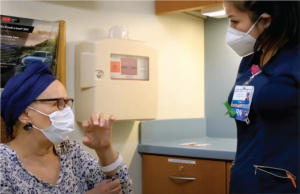
Trinitas Regional Medical Center

The Girl Outside • Sonia Braga
Braga returned to Brazil and, unfortunately, began experiencing abdominal pain, which was caused by metastatic cancer in a different area. This time, however, she remained positive as her doctors put her on alternate medication. Dr. Cholankeril believes that the therapy Braga received at Trinitas helped her accept the recurrence and remain in high spirits.
Braga agrees.

The Old Girl • Sonia Braga
“The mental health treatment helped me to deal with the cancer,” she says. “I want to go through this in the best way, to enjoy every step. I will use this cancer to be better, to live better.”
This is clearly evident in her photography, she adds.
“If you look at the work I did before, while suffering from depression, you can see the pain,” she says. “After that, my photos have more life, more hope.”
At Trinitas, Braga says, they made her feel welcome and special, treating her as a person, not just a patient.
“And it’s not just the doctors,” she points out. “It starts at the front desk. You feel safe here…because everything works with love.”
Did You Know? The air conditioning industry came of age in the Garden State.
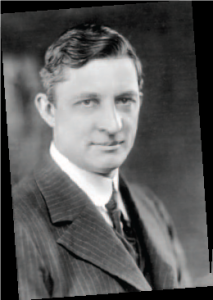
Carrier Corp.
The summer of 1902 was a particularly brutal one in the metropolitan area. The sweltering heat and oppressive humidity was especially devastating for the printing industry. Paper grew and shrank, which meant it was a slightly different size every time it ran through a color press—resulting in poor-quality images. In response, Willis Carrier (left), a 25-year-old Cornell-educated engineer, drew up plans for a machine that cooled, filtered and circulated the air and controlled the humidity. In 1914, Carrier and six other engineers pooled their collective life savings to form the Carrier Engineering Corporation. Its first customer was the American Ammunition Company, in South Jersey. Its second was the Masonic Lodge in Philadelphia, which ordered a system designed to deliver human comfort as opposed to a more productive working environment—a novel idea at the time.
In 1918, Carrier opened a research lab in Newark. After World War I, the company established its major production facility nearby, on Frelinghuysen Avenue. It is difficult to overstate the impact of air conditioning on the American experience. The ability to cool large work spaces in hot weather was a game-changer for US industry, supercharging year-round productivity. In some businesses, like meat packing, sales nearly doubled. The introduction of home air conditioners in the 1930s triggered a population shift to the Sun Belt, which continues to this day. Here’s a look at some touchstone moments in air conditioning…
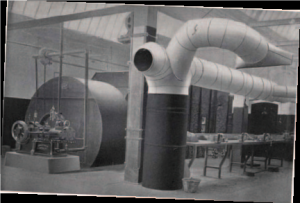
1912
Early ductwork in the pressroom of Dittman-Steidinger Printing in New York.
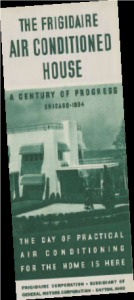 1934
1934
Appliance-maker Frigidaire quickly got into the business of residential air conditioning.
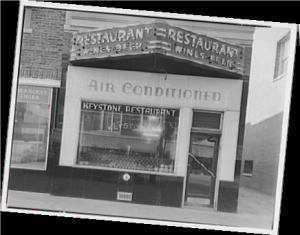 1935
1935
AC was a summertime game-changer for restaurants.
 1940
1940
AC was viewed as a luxury during the Depression—and sometimes the butt of jokes.
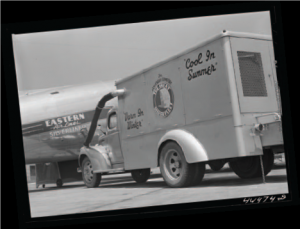 1943
1943
The promise of AC in automobiles suggested a cool future.
 1941
1941
Before AC was installed in passenger planes it was supplied by trucks on the tarmac.
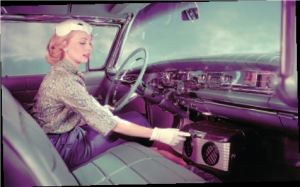 1952
1952
By the 1950s, AC was an expensive but popular new-car option.
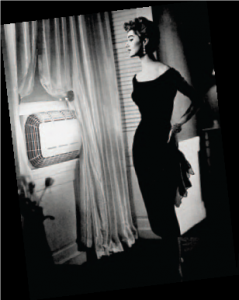 1954
1954
Early window air conditioners were designed with both fashion and function in mind.
 1971
1971
What better way to say “I love you” than with central air?
The pros and cons of creating your place in the sun.
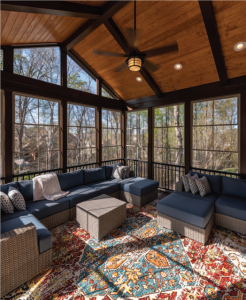
www.istockphoto.com
Something kind of wonderful is happening this spring. For the first time in more than three years, if you call a contractor for a major renovation, someone might actually pick up the phone. The pandemic did odd things to the building industry in New Jersey and it finally seems to be sorting itself out. The pandemic also did something odd to the millions who were stuck at home all day—it made us understand the value of letting more light into our lives. Which is a roundabout way of saying that this may be the year that a lot of Garden State homeowners consider brightening things up by adding a sunroom.
Hank Longo, who has built more than 100 sunroom additions over the last 16 years, confirms that business is already booming. The VP of Additions for All Counties Exteriors in Lakewood calls it “Covid Sanctuary Syndrome.” The word sunroom, he adds, is a generic term. It means different things to different people and covers a lot of options from the economical to the extravagant. The common denominator is the promise of bringing more of the outdoors inside.
Sunrooms are often categorized by the type of construction used. Site-Built refers to on-site construction, which requires a firm foundation and utilizes standard tools, materials, supplies and experienced labor. A four-season sunroom usually includes electricity, plumbing, heating and air conditioning. Bump-Outs are less complicated and more budget-conscious than the site-built alternative. Rather than a full-scale addition, they typically are an Glass Houses are at the high end of the expense spectrum. Basically, everything is designed to let in the light, including the roof. This type of sunroom type is often called a conservatory or sun parlor—basically a live-in greenhouse attached to your home. The only non-glass element is the hardscaped floor, which is often made of ceramic tile or stone with built-in drainage to make cleanup easier after waterings. Heating, cooling and humidity control systems are add-on expansion to an existing room. Pre-Fab Kits are exactly what they sound like. They are made of steel or aluminum framing, with a number of options for the type of glass, roofing and insulation. A contractor can assemble a pre-fab sunroom or an adventurous homeowner could even be tempted to make it a DIY project. a must for four-season enjoyment. Back Porch Conversions involve incorporating most of the existing porch or patio structure at the back of a home by replacing old-fashioned open or screened windows with the latest tempered glass products. A sturdy foundation is a must for this type of sunroom project.

www.istockphoto.com
In addition to different types and styles of construction, sunrooms also offer several roofing choices. A sunroom roof can complement the style of the existing house or it can be more architecturally distinct while remaining aesthetically pleasing. A Gable Sunroom is a glass structure topped with two roof panels supported by a center beam. A Studio Sunroom has only a single sloped panel. A Garden Sunroom is usually equipped with extra-thick double-paned glass that acts as insulation.
Call it a solarium, call it a conservatory, call it whatever you want. No matter what you call it, a sunroom is the best seat in the house. However, as with any major project, the inevitable question is, How much will it cost?
As most contractors will agree, the first step in any project of this type is deciding on what you want from your sunroom. Is it a peaceful green retreat? An entertainment center? A home office? A yoga or art studio? A noisy gameroom? A cozy breakfast nook? The next step is understanding the factors that affect the price involved in getting everything you want. Let’s begin with fleshing out what you do want. The types of sunrooms and their labels help to conceptualize the final “look and feel” of the finished project. Once you have decided on the type that suits you and your family best, then prioritizing your wish list always helps when it comes to trimming the budget.
For example, factors to be considered should begin with the size of the sunroom, since how big always affects how much. There are other considerations, such as the cost of materials and the cost of labor—which should always be listed separately in any proposal or contract. Other costs include permitting, architectural plans, site prep, new vs. existing foundation, extra cleanup and how local building codes might impact your plans. A sunroom obviously adds to the value of a home, but will you recoup this expenditure if and when you sell? For some, that consideration is immaterial—they want what they want and they have the funds to make it happen. For others, the value added needs to be within range of what they’ll have to spend. Longo has the experience to provide his clients with a realistic idea of the cost, as well as the prospects of clawing some of that back down the road. “I have been in business long enough for me to be honest with each client about their return on investment in a sunroom addition,” he says. “It’s the only way to go.”
In a recent article in Forbes Home magazine, statistics for three-season sunrooms in the metropolitan area ranged from $80 to $230 per square foot, while this escalated to $200 to $400 per square foot for a four-season addition. This translates to average costs of $25,000 to $40,000 and $45,000 to $80,000, respectively. Of course, all this data is based on averages, and your vision for your own sunroom may not be very average. However, there are some interesting final average ranges that relate directly to costs by sunroom types:
- Pre-fab $5,000 – $30,000 (minimal cost if you are equipped to DIY)
- Solarium $30,000 – $75,000 (not only are the walls glass, but the roof is, too)
- Conservatory $50,000 – $150,000 (true garden room, a “greenhouse for people”)
- Atrium $6,000 – $20,000 (interior room with a glass roof but with existing walls incorporated)
I reached out to some other contractors to get a sense of the Pros and Cons before launching into a sunroom build.
South Amboy – $849,000
Franklin Twp – $639,000
2 Sand Piper Drive
Lighthouse Bay Waterfront Community with spectacular views. Corner lot, relaxing open front porch, private yard with spacious paver patio.
368 Windfall Lane
55+ Gated Community, 3 BR & 3 full baths in this 3,000 sq. ft. home. Minutes from transportation, theater, fine dining, golf & state park trails.

www.istockphoto.com
PROs
✓ If money matters (and it always does), there are many practical ways to control costs, the biggest being whether you want a three- or four-season sunroom.
✓ If value-added matters, the average return on investment should be at least half of what you spend.
✓ If your mood needs lifting and your immune system needs boosting, then the Vitamin D of natural sunlight brought indoors can be healing both mentally and physically.
✓ If your green thumb aches for more time outdoors, then you can extend your year-round gardening pleasure by moving indoors.
✓ Versatility—whether for family fun or for private meditation and reverie, your sunroom can be designed accordingly.
CONs
✓ By adding value, you might be facing not only an increase in property taxes, but there might also be a rate hike in your insurance premiums. Best to check ahead.
✓ Higher utility bills are inevitable, especially when four-season comforts are included.
✓ If lack of privacy is a concern, you may end up installing blinds, drapes or other window treatments.
✓ A three-season sunroom will become uncomfortable when temperatures plummet outside, requiring some type of auxiliary heating in order to keep the sunroom open and comfortable for as long as possible.
✓ You will want to add a duct and vents to your cooling system to keep things comfortable come summer—particularly with a southern exposure.

www.istockphoto.com

www.istockphoto.com
Finally, a few thoughts on greenhouses. Although a greenhouse technically qualifies as a type of sunroom, it differs from most other types by being a far more practical structural alternative. It is revered by ardent gardeners for the protection it provides for plants, flowers and vegetables whose health (and often survival) depend on it. The focus of a typical greenhouse is on the vegetation it helps to produce, rather than on the creature comforts of the resident gardening enthusiast. Greenhouses extend and improve growing seasons by sheltering against the elements and possible pest invasions. Their primary purpose is to keep heat in, which has popularized the label hot house for any greenhouse that can maintain a temperature of 60 degrees or more throughout the year.
Greenhouses come in many styles: A-Frame, Dome, Gothic (arched), Quonset (designed in 1941 by a team of naval engineers), or Lean-To (against an existing wall of a home or garage as one side). A greenhouse decision involves analyzing pros and cons in the same way as for the grander sunroom candidates above. One benefit unique to greenhouses is keeping everything gardening-related (pots, tools, supplies) under one roof, eliminating the need for a separate storage shed. And greenhouses can deliver plants, cutting flowers and seasonal veggies whenever you want throughout the seasons.
A significant drawback, however, is that any greenhouse requires constant monitoring, maintenance and a healthy dose of TLC. Depending on its style and location, the greenhouse may also detract aesthetically from the rest of the garden. And it can get expensive in the winter if you want to keeping it operating all year round. Perhaps the best way to consider the greenhouse vs. sunroom question is this: Although both are wonderful places to be, a greenhouse is a working space, while a sunroom is a living space.
A plant-based training table is the key to optimizing performance.

www.istockphoto.com
I remember the exact moment I understood the phrase “hitting the wall.” I signed up to run a half-marathon right before my thirtieth birthday, even though I had never run more than three consecutive miles. I figured it shouldn’t be too bad—I was healthy and, just like many new (and sometimes experienced) athletes, I thought good overall nutrition would carry me through the 13.1 miles. When I did the run, I felt terrible and I couldn’t understand why. I didn’t know I needed the extra carbs and sugar that are necessary for long-distance running, and I thought I’d consumed enough water throughout the day to stay properly hydrated. I couldn’t have been more wrong.
Sports nutrition, I would come to understand, is different than general nutrition.
General nutrition is about eating the right nutrients for overall health. Sports nutrition? It has much more nuance, including nutrient timing, meal composition and hydration. Throw plant-based eating into the mix, and you’ve got a recipe (pun intended) for confusion. As a registered dietician, I admit I may be biased, but I believe that plant-based nutrition can play as important a role in performance as training. In fact, choosing the right foods at the right time can profoundly enhance your performance.
Something else I have learned is that those foods don’t have to be boring, complicated, or tasteless. Protein is the number-one concern among many plant-based athletes. If you are a tournament tennis player, an ocean swimmer, a long-distance cyclist, a serious runner like me, or just a workout monster, you may be wondering if you’re getting enough protein on a plant-based diet. Or perhaps you struggle to understand how much you need daily. Let me assure you that eating enough protein on a plant-based diet is feasible and easy.
There are a couple of calculations you need to grasp when it comes to protein, namely the relationship between portion size and protein source. Generally speaking, you may need to increase your portion sizes when cutting meat from your diet because plant-based foods tend to be lower in calories and protein than animal foods. For example, three ounces of tofu have about 10 grams of protein and 90 calories, whereas three ounces of chicken have about 20 grams of protein and 200 calories. Consequently, you need to eat double the amount of tofu to get the same nutrients as chicken. However, tofu isn’t the only source of protein on a plant-based diet. Beans and legumes, other soy products, nuts and seeds, and whole grains are also excellent sources.

www.istockphoto.com
Protein is one of three primary macronutrients that the body needs in significant amounts in order to provide calories and energy for basic daily functioning. The other two are carbohydrates and fat. Although foods are often categorized as “carbs” or “fats” or “proteins,” it is important to recognize that most foods contain a combination of at least two, if not all three. It’s also important to understand more about each macronutrient in order to maximize its benefits to your workout and training goals.
Another concern of athletes who fuel their performance through a plant-based diet is whether they are getting the proper amounts of micronutrients—the vitamins and minerals that come from food. There is a long list of essential vitamins and minerals, and some are less prevalent in plant-based foods. I like to refer to these as “micronutrients to watch.” The most critical are iron, calcium and vitamin B12. It requires a bit more effort to make sure you don’t end up with a deficiency in these areas, but it’s not difficult once you get into a habit of it.
The question I receive most often is, What should I eat before my workout? Which brings me to meal timing. If macronutrients are the “who” of fueling, meal timing is the “when, what, and why.” Having a solid understanding of what to eat before, during and after a workout can help you build a quick and simple meal when you don’t have time to cook. Trust me, a small tweak to your fueling routine can make a big difference. In putting together the book Planted Performance, I probably spent as much time addressing meal timing and meal plans for different types of training regimens— and how to incorporate recipes into your training day—as I did on the recipes themselves.
If you’ve read this far, chances are you’re either already on a plant-based diet or you’re looking to incorporate more plants into your diet and need a boost. Either way, you may suffer from the common misperception that it is difficult to put a delicious, hearty dinner on the table that fills you up without weighing you down—particularly if there are others at that table who haven’t fully embraced a plant-based diet. The fact is that you can absolutely make a well-balanced, delicious, plant-based dinner with a mixture of the three key macronutrients (carbohydrates, protein and fat), as well as vitamins, minerals and antioxidants.
The filling meatless mains in the pages that follow will not only satisfy your taste buds, but also help you refuel and recover for tomorrow’s training.
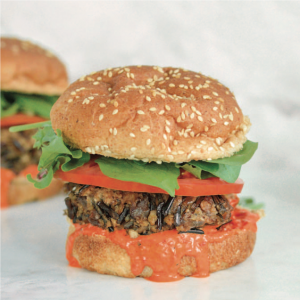
Courtesy of Natalie Rizzo
Wild Rice and Mushroom Umami Burgers with Roasted Red Pepper Aioli
These burgers combine savory ingredients with a vibrant vegetable sauce. If you prefer to use an egg in place of the flax meal mixture, go right ahead!
For the patties:
2 tablespoons flax meal
6 tablespoons warm water
1 tablespoon vegetable oil
1⁄2 cup diced white onion
2 cloves garlic, minced
1 cup diced white mushrooms
1⁄4 cup raw unsalted walnuts, finely chopped
2 tablespoons low-sodium soy sauce
1⁄2 teaspoon ground cumin
11⁄2 cups cooked wild rice
1⁄2 cup panko bread crumbs
For the roasted red pepper aioli:
1⁄2 cup mayonnaise or vegan mayonnaise
1⁄4 cup roasted red bell peppers
1 clove garlic
1⁄8 teaspoon salt
4 hamburger buns, for serving
Lettuce, for serving
Sliced tomato, for serving
Line a baking sheet with parchment paper.
To make the patties, in a small bowl, make a flax egg by combining the flax meal and water. Let sit for at least 5 minutes, until the mixture thickens slightly.
Warm 1 tablespoon of vegetable oil in a large skillet over medium heat. Add the onion and garlic and cook for 2 to 3 minutes, until the onion is translucent. Add the mushrooms, walnuts, soy sauce, and cumin and cook for 3 to 4 minutes, until the soy sauce reduces. Remove from the heat.
In a large bowl, combine the flax egg with the vegetable mixture. Add the wild rice and bread crumbs. Mix until well combined.
Form four equal patties from the mixture and place them on the prepared baking sheet. Refrigerate for at least 1 hour to set.
While the burgers are setting, make the aioli. In a food processor, combine the mayonnaise, roasted red bell peppers, garlic, and salt and process until smooth.
Heat 1 tablespoon of vegetable oil in the same large skillet over medium-high heat. Place the burgers on the pan and cook for 4 minutes on each side, until they are golden brown.
To assemble, place the patties on buns, then top with aioli, lettuce, and tomatoes. Serve right away or store in a sealed container in the fridge for up to 5 days or in the freezer for up to 1 month.
Makes 4 servings Prep Time: 10 minutes, plus 1 hour to chill Cook Time: 15 minutes

Courtesy of Natalie Rizzo
Sweet Potato and Black Beans Enchiladas
Enchiladas may seem like a complicated dish but making them at home is easier than you think. Feel free to use vegan cheese or leave off the cheese entirely.
1 sweet potato, cut into large chunks
1 cup chopped cauliflower (about 1⁄2 small head)
1⁄3 cup diced red onion, plus more for serving
1 tablespoon diced jalapeño, plus slices for serving
2 cloves garlic, minced
2 tablespoons vegetable oil
1 teaspoon chili powder
1⁄4 teaspoon ground cumin
1⁄4 teaspoon salt
1 can (15.5 oz) black beans, drained and rinsed
2 tablespoons fresh lime juice
6 (8- to 10-inch) soft flour tortillas
1⁄2 cup salsa verde
1⁄2 cup shredded Cheddar cheese, Mexican cheese blend, or vegan cheddar
Diced red onion, for serving
Sliced jalapeño, for serving
Chopped fresh cilantro, for serving
Preheat the oven to 375°F. Line a baking sheet with parchment paper.
Bring a large pot of water to a boil over high heat. Add the sweet potato and cook for 20 minutes, until fork tender. Drain the water and set the sweet potato aside. Remove the skins from the sweet potatoes and place the flesh in a large bowl. Mash the flesh with a fork.
Meanwhile, in a large bowl, combine the cauliflower, onion, jalapeño, garlic, vegetable oil, chili powder, cumin, and salt. Stir until well combined. Spread the cauliflower mixture on the prepared baking sheet and bake for 20 minutes, until golden around the edges.
Transfer the roasted cauliflower back to the large bowl. Add the black beans and lime juice and stir well.
Lay each tortilla flat and fill the middle of each tortilla with the vegetable mixture before rolling them up.
Place half of the salsa to the bottom of a 9×13-inch casserole dish. Place each filled tortilla in the casserole dish with the rolled part facing down. Add the remaining half of salsa and the cheese on top. Bake for 20 minutes, until the cheese is fully melted.
Remove the enchiladas from the oven and garnish with red onion, jalapeños, and cilantro. Serve immediately or store in a sealed container in the fridge for up to 5 days.
Makes 4 servings Prep Time: 10 minutes / Cook Time: 1 hour

Courtesy of Natalie Rizzo
Greens and Beans Soup
White beans are a standout ingredient in this soup due to their nutrition profile. Not only are they a good source of plant-based protein and fiber, they are also an excellent source of iron and folate, two nutrients necessary for blood and brain health.
2 tablespoons extra-virgin olive oil
2 stalks celery, chopped (1/2 cup)
2 carrots, chopped (3⁄4 cup)
¼ white onion, diced (¼ cup)
4 cloves garlic, minced
1 cup chopped artichoke hearts
1 teaspoon dried rosemary 3⁄4 teaspoon salt
¼ teaspoon dried thyme
2 (15.5 oz / 439 g) cans cannellini beans, drained and rinsed
4 cups low-sodium vegetable broth
1 cup water0
2 tablespoons fresh lemon juice
2 cups packed packed chopped stemmed kale
Salt and freshly ground black pepper

www.istockphoto.com
Warm the olive oil in a large stockpot over medium heat. Add the celery, carrots, onion, garlic, and artichoke hearts and cook for 3 to 4 minutes, until translucent. Add the rosemary, salt and thyme, and stir. Cook for 5 minutes.
Add the beans, broth, water, and lemon juice and bring to a boil. Reduce the heat to low, cover, and simmer for 20 minutes, until the vegetables are soft.
Using an immersion blender, blend the soup until it has reached a very chunky consistency; you should still be able to see full beans and vegetables. If you don’t have an immersion blender, transfer half of the soup to a blender and blend, then put it back in the stockpot with the remaining soup.
Add the kale to the pot, increase the heat to high, and bring to a boil. Reduce the heat to low, cover, and simmer for another 10 minutes, until the kale is wilted. Season to taste with salt and black pepper.
Serve immediately or store in a sealed container in the fridge for up to 7 days or in the freezer for up to 3 months. Heat before serving.
Makes 4 servings Prep Time: 10 minutes / Cook Time: 45 minutes
The benefits of plant-based diets, including vegetarian and vegan diets, have been well studied for their role in disease prevention and overall health. They are rich in whole foods such as fruits, vegetables, beans, legumes, nuts, soy, seeds and whole grains, and contain plenty of beneficial nutrients—including vitamins, minerals, fiber and antioxidants.
The American Institute for Cancer Research recommends that Americans consume two-thirds of their dietary intake from vegetables, fruits, whole grains and beans. In the 2015–2020 Dietary Guidelines for Americans, vegetarian diets are recommended as one of three healthy dietary patterns.
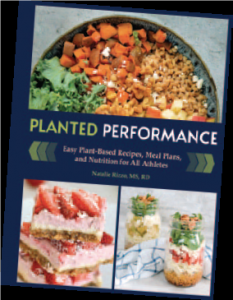 Vegetarian diets also improve several heart-disease risk factors, including abdominal obesity, blood pressure, blood lipids and blood glucose. What’s more, for those who suffer from risk factors for heart disease, such as high cholesterol, a vegetarian diet may reduce cholesterol levels, decrease markers of inflammation, protect against plaque formation in the arteries and improve heart health without the use of cholesterol-lowering drugs. Consequently, vegetarians have a reduced risk of developing (and dying from) heart disease. Researchers attribute these benefits to the abundance of fiber and the scarcity of saturated fat in vegetarian and vegan diets. Additionally, compared with meat-eaters, vegetarians and vegans have a lower risk of developing type 2 diabetes and cancer, especially gastrointestinal cancer. EDGE
Vegetarian diets also improve several heart-disease risk factors, including abdominal obesity, blood pressure, blood lipids and blood glucose. What’s more, for those who suffer from risk factors for heart disease, such as high cholesterol, a vegetarian diet may reduce cholesterol levels, decrease markers of inflammation, protect against plaque formation in the arteries and improve heart health without the use of cholesterol-lowering drugs. Consequently, vegetarians have a reduced risk of developing (and dying from) heart disease. Researchers attribute these benefits to the abundance of fiber and the scarcity of saturated fat in vegetarian and vegan diets. Additionally, compared with meat-eaters, vegetarians and vegans have a lower risk of developing type 2 diabetes and cancer, especially gastrointestinal cancer. EDGE
Editor’s Note: Natalie Rizzo, MS, RD, has been a vegetarian for more than a decade and a competitive runner for almost as long. Her new book Planted Performance: Easy Plant-Based Recipes, Meal Plans, and Nutrition for All Athletes (NewSeed Press, 2023) simplifies complex sports nutrition information and contains chapters on meal plans, pre-workout breakfasts and lunches, hearty dinners, side dishes and desserts. Portions of this story and all three recipes appear in her book. Natalie is the owner of Greenletes.com, a plant-based sports nutrition blog and podcast. She has written for numerous sports and fitness publications and frequently appears in television segments on health and wellness.

The fuss over TikTok…and why you should care.

www.istockphoto.com
There are more than 8 billion humans on this planet and, if you believe what you read, more than a billion actively watch TikTok videos. If TikTok were an organized religion—and for many young people it kind of is—it would rank third behind Christianity and Islam, possibly tied with Hinduism. For the record, the population of TikTok accounts is growing faster than the population of Hindus.
If you’ve never watched TikTok or don’t understand what it is, don’t feel bad. Most people on TikTok don’t really know either. They’re too busy having fun.
The app itself, which began as a platform for short, hyper-expressive homemade videos—particularly amusing dance videos and pop songs—was created by a company called Musical.ly and purchased in 2017 by the Chinese company ByteDance for $800 million. It took off during the pandemic, especially among teens and twenty-somethings. Influencers moved en masse to the app from Facebook, Instagram and Twitter, and advertisers followed. In 2021, TikTok raked in more than $4 billion in advertising revenue. In 2022, that number more than doubled—at a time when ad revenue for digital competitors sagged. That has people like Mark Zuckerberg more than a little concerned; he has gone so far as to warn that TikTok’s growing dominance is a threat to the US tech sector.

www.istockphoto.com
TikTok content has evolved somewhat, but not a lot. It’s still silly and stupid and crazy and imaginative. There’s just a lot more selling than there used to be. Unlike other social media apps, where the inclusion of ads is fairly obvious, TikTok advertisements are often disguised as one of the endless short videos that flow across the small screen, one after another, based on algorithms keyed to a user’s interests. Often, you don’t know you’re watching a commercial until its mostly done. If it’s good, you don’t even care.
For many, TikTok has become addictive. The average user spends on average more than 90 minutes a day glued to the app. In this country, there are around 100 million active users. That is an impressive digital footprint. To some, it is a threatening one.
Joe Biden and Donald Trump don’t agree on much, but one thing they have in common is a deep distrust of TikTok. Both of their administrations tried to curtail its influence. They weren’t concerned with the deleterious effect on young minds. It was the Chinese-owned part of TikTok that raised all kinds of red flags (no pun intended). ByteDance has consistently assured our government that the data it collects on Americans stays in America, on American servers. Yet Chinese law is very clear that its government can demand data from US affiliates of Chinese companies. So which is it?
US officials have been pressuring ByteDance to change its ownership here so that the direct link to China is severed. The Biden administration considers it a national security issue. The US military has banned the app on personal devices, as has TSA and a handful of state governments, including Texas. Many politicians on both sides of the aisle would like to see the app banned altogether.
In late-December, the big omnibus spending bill passed in Congress included a new regulation that prohibited federal government employees from downloading the TikTok app on their mobile devices—and instructing those who already have it to delete it. Senator Marco Rubio introduced a bipartisan bill on December 13th banning TikTok in the US altogether.
There is another issue generating profound concern over the growth of TikTok and that is its ability to prevent underage users from accessing violent, hateful, drug-related or sexual content. Right now, the minimum age to open a TikTok account is 12. Raising the minimum age to 17 or 18 has been discussed but, naturally has met with all kinds of resistance from the company. There is now a consumer protection lawsuit in Indiana around this issue. The Attorney General claims that TikTok has deceived children and their parents with the age rating of 12, dishonestly leveraging consumer trust in app stores like Google’s and Apple’s.
In 2021, TikTok introduced a feature enabling parents to link their TikTok accounts with that of their children, which theoretically would enable moms and dads to monitor and control what their young teens are watching. And the app has special filters to identify, delete and punish offensive videos before they reach young eyes. Not surprisingly, there are myriad work-arounds for these safeguards, including the use of alternative words for ones that are likely to be caught in the algorithm, such as “unalive” for “kill” and “seggs” for “sex.” There is even a word for this new vocabulary: Algospeak.
The problem is that TikTok is fun and cool and easy to use. It is a brilliant cure for boredom and a break from reality. And in the way that Facebook used to say it was the new office water cooler, TikTok has become the younger, hipper version of that.
Anyone with a smartphone can make a TikTok video in a matter of minutes. People who go about their lives otherwise unnoticed can have hundreds or thousands of followers. An ad that might only get a few glances somewhere else can rack up millions of views and increase sales by 100 or 500 or 1,000 percent. TikTok is the most efficient way to attract, influence and capture young consumers, who eagerly share what they like and willingly tumble down the TikTok rabbit hole.
While TikTok’s supporters hail it as a new cultural and communications frontier, its critics have called it a Trojan Horse, a Wolf In Sheep’s Clothing and—especially resonant for those who recall the notorious R.J. Reynolds cigarette campaign of the early 1990s—Joe Camel on Steroids.
A play list you won’t see anywhere else.
There have been at least a couple of dozen films that play off the word “straight”—stretching all the way back to the silent-movie era. It’s a word with multiple definitions and uses, as well as new meanings in language and culture. We’ve picked the eight most noteworthy examples, including a couple of classics and more than a few that flew under the radar and are now worth a second look.
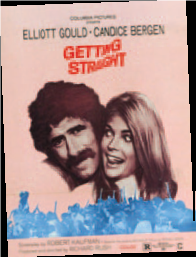
Getting Straight • Columbia Pictures
Getting Straight • 1970
If you ever wondered what an actor like Elliott Gould could do to elevate a so-so script, Getting Straight is a textbook example. Set in the late-1960s, this “serious comedy” follows a Vietnam vet trying to get his teaching degree on a college campus roiling with student unrest. Candice Bergen co-stars as his girlfriend, who just happens to be the leader of the escalating demonstrations. Look closely and you’ll see teenaged Harrison Ford in one of his first speaking roles.

Straight Time • Warner Bros.
Straight Time • 1978
In an era when many big-name stars sold out for big-budget movies, Dustin Hoffman remained true to his craft, picking scripts that challenged him and his audiences. Straight Time is a wonderfully gritty “neo-noir” film that profiles a disillusioned ex-con who simply isn’t wired to rejoin society…and it’s up to us to figure out why. The supporting cast—which includes Kathy Bates, Gary Busey, Theresa Russell, Harry Dean Stanton and M. Emmett Walsh—is terrific.

Scared Straight! • Golden West Television
Scared Straight! • 1978
Filmed at Rahway State Prison—and relentlessly parodied on Saturday Night Live—this film was not only acclaimed in its time…it won an Academy Award for Best Documentary. Scared Straight! shows a riveting three-hour session between cocky juvenile offenders and hardened criminals. The film was aired on television uncensored, marking the first time that many stations allowed foul language to be broadcast. Peter Falk served as the narrator.
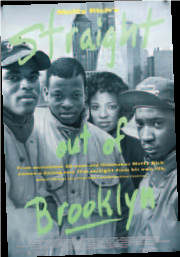
Straight Out of Brooklyn • The Samuel Goldwyn Co.
Straight Out of Brooklyn • 1991
More than a decade before Lawrence Gilliard Jr. earned fame as D’Angelo Barksdale on The Wire, he portrayed Dennis, a Brooklyn teenager desperate to break free of the cycle of poverty and domestic violence that is dragging him down. His solution is to rip off a local drug dealer and move his family out of the projects, but he and his buddies get more trouble than they bargained for. George T. Odom, who plays Dennis’s father is particularly good in a movie that received glowing reviews and won a special jury prize at the Sundance Film Festival.
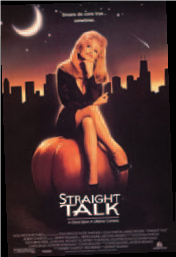
Straight Talk & The Straight Story • Buena Vista Pictures
Straight Talk • 1992
This classic 90s Rom-Com features good performances from James Woods and Dolly Parton, along with talented supporting players John Sayles, Griffin Dunne, Teri Hatcher, Spalding Gray, Jerry Orbach and Michael Madsen. Parton fans snapped up the soundtrack, which featured 10 original songs by Dolly. The movie is a lighthearted commentary on radio therapists, as Parton’s character rockets from a switchboard operator to beloved “Doctor Shirlee” shortly after moving from Arkansas to Chicago. Woods plays the journalist who discovers she is no doctor at all.
Honorable Horrible Mention
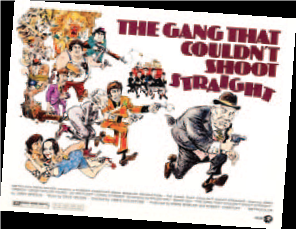
The Gang That Couldn’t Shoot Straight • Metro-Goldwyn-Mayer
The Gang that Couldn’t Shoot Straight • 1971
How bad could a mob comedy featuring the talents of Robert De Niro, Burt Young, Jerry Orbach, Joe Santos and Frank Campanella be? The words borderline unwatchable come to mind. The movie, based on Jimmy Breslin’s book about Crazy Joe Gallo, is an unfunny mess. Al Pacino was originally going to be the star, but opted out to play Michael Corleone. Francis Ford Coppola planned to direct until producer Irwin Winkler decided he lacked the skills to make a Mafia movie so, as every film buff knows, Coppola ended up directing Pacino in a pretty good flick called The Godfather. The Gang that Couldn’t Shoot Straight features the film debut of Herve Villechaize, but his voice is dubbed throughout.
Did You Know?

Beavis & Butt-Head • Fleer Corp.
In the MTV cartoon series Beavis and Butt-Head, the boys are ordered to attend a Scared Straight! program…and have so much fun they try to get back into the prison.
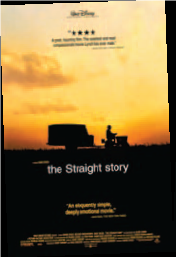
Straight Talk & The Straight Story • Buena Vista Pictures
The Straight Story • 1999
David Lynch has made some of the most imaginative and compelling films in recent history, including The Elephant Man, Blue Velvet and Mulholland Drive. Why The Straight Story is rarely part of this list is difficult to understand. The true story of Alvin Straight, who drove 240 miles from Iowa to Wisconsin on a riding mower to visit his ailing brother, it co-stars Richard Farnsworth, Sissy Spacek and Harry Dean Stanton. Each actor is capable of teaching a master class and, in this film, they pretty much do. Unfortunately, critical acclaim and numerous awards did not translate into big box office for this uncharacteristically sentimental Lynch oeuvre.

Straight Outta Compton • Universal Pictures
Straight Outta Compton • 2015
Rap video producer F. Gary Gray directed this biopic about the origins of the multi-platinum rap group N.W.A., led by Ice Cube, Eazy-E and Dr. Dre. O’Shea Jackson and Jason Mitchell do brilliant work playing Ice Cube and Eazy-E, respectively, while Paul Giamatti plays their slick manager, Jerry Heller. The movie title comes from N.W.A.’s 1988 hit of the same name. You don’t have to love rap or even care about its evolution to enjoy this movie, which follows the group’s rise and fall.
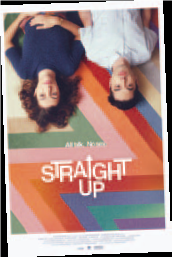
Straight Up • Strand Releasing
Straight Up • 2019
A small independent film that was partially crowd-funded and shot in under three weeks, Straight Up challenges the idea of what a love story is when it doesn’t include sex. Todd suffers from OCD and isn’t a fan of bodily fluids. He meets Rory—a struggling actress who has difficulty forming emotional connections—in the self-help section of a library. Writer-director James Sweeney plays Todd, while TV veteran Katie Findlay plays Rory.
If shingles “doesn’t care,” should you take that personally?

www.istockphoto.com
If you watch any amount of cable news or network television, you’re probably under the impression that shingles is more than a disease. It’s an inevitability. After all, anyone who’s had chicken pox as a kid already has the virus, right? Scarier still is the seeming randomness of shingles: “Almost one in three people will develop shingles in their lifetime.” Who is this person? Who are the other two? And is there some indicator or precondition or lifestyle choice that tilts the odds against me?
These are all reasonable questions your healthcare provider can answer on your next visit. Until then, here are a few facts to mull over.
According to the CDC, that “almost one-in-three” statistic is accurate. Older adults are far more likely to develop shingles than young adults, and shingles in children is extremely unusual. The hot-poker/electric-shock special effect in the commercials is not an overstatement of the nerve pain some people experience at the site of the shingles rash—its technical name is postherpetic neuralgia (PHN)—but fewer than 20% of shingles sufferers actually experience PHN. For most, it’s about the itch.
Although shingles is usually a one-and-done condition, it is possible to have a recurrence. Also, really bad cases can lead to hospitalization. According to the CDC that number is between 1 and 4%, and is usually a combination of old age and a suppressed or compromised immune system. Rates of shingles cases among older Americans have remained steady for 15 years, but have increased somewhat among younger adults. No on one is certain why that is.
In most cases, shingles presents as a band-like rash on one side of the body, or on the face. You’re likely to get a warning sign, such as an itch or tingling in the area where the rash is about to occur. The rash itself blisters and then scabs over and clears up in less than a month. During that time, shingles sufferers may experience fever or headaches and nausea.

www.istockphoto.com
Shingles respond to a number of antiviral medicines, which shorten the length and severity of the illness. The sooner treatment begins, the more effective it tends to be. Even when the pain is mild, the itch can drive you a bit mad, so doctors will typically suggest wet compresses, oatmeal baths and old reliable calamine lotion. Certain foods should also be avoided during an outbreak, including dark chocolate and soy products, which contain the amino acid Arginine. Most doctors will advise you to pump the brakes on caffeine and alcohol during recovery.
If you develop shingles, or know someone who has, rest assured that shingles cannot be directly transmitted. However, those who have never been vaccinated for chicken pox, or never had it, can develop chicken pox after coming into contact with fluid from shingles blisters.
In almost all cases, as the commercials say, the virus has been in your body since childhood (especially if you were born in the 1970s or earlier). The chicken pox virus, varicella zoster (VZV), can stay dormant in the human nervous system for decades and then suddenly reactivate.
Shingrix, the recombinant zoster vaccine (RZV) is recommended by the CDC for people over 50 and for younger adults whose immune systems have been weakened by disease or therapy.
“Adults 50 years and older should get two doses of Shingrix, separated by two to six months,” says Dr. Muniba Naqi, an internal medicine specialist at Trinitas. “Younger adults 19 years and older who have—or will have—weakened immune systems should also get two doses of Shingrix. Diseases that weaken the immune system include chronic inflammatory conditions such as lupus and rheumatoid arthritis, or any underlying malignancy, as well as HIV and transplant patients.”
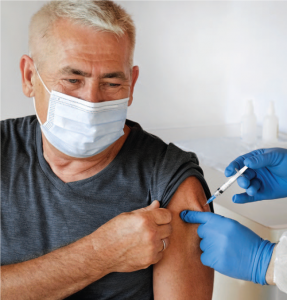
www.istockphoto.com
Shingrix has proven to be more than 90% effective in preventing shingles and PHN, and provides strong immunity for at least seven years. It replaces Zostavax, an older vaccine that was far less effective.
“Some people will develop shingles despite vaccination,” cautions Dr. Naqi. “However, the vaccine may reduce its severity and duration. It can also reduce the risk of postherpetic neuralgia, the shingles complication that causes pain to continue long after the blisters have cleared.”
So who gets shingles and who doesn’t? First off, you don’t “catch” shingles. The best answer, unfortunately, is the vaguest. VZV appears to have the highest chance of reactivating when your immune system isn’t functioning at 100%.
As we age, it becomes increasingly difficult to maintain a high-functioning immune system, which is why the older you get, the more likely you are to be one of the “nearly one in three” that develops shingles. Other contributors can include heavy use of anti-inflammatory medications, as well as the immune-suppressing meds associated with Crohn’s disease, lupus and rheumatoid arthritis—which are in line with the disease Dr. Naqi lists.
Finally, there’s our old friend, stress. Stress can do a number on your immune system, sometimes without your even knowing it. Not only can it open the door enough to reactivate VZV, it can also make the symptoms of shingles much worse once you have it.
 Editor’s Note:
Editor’s Note:
Dr. Muniba Naqi is an internal medicine specialist and Medical Director of Hospitalist Medicine at Trinitas. Dr. Naqi has been the founding Medical Director for the Trinitas Hospitalist Department for the past seven years.
One of the most revered and innovative tennis coaches in the North-east also happens to be the preeminent authority on the culture and history of black tennis. In fact, Arthur A. Carrington Jr. wrote the book on it. Born and raised in Elizabeth, he learned the game at the legendary North End Tennis Club and, in the 1960s and ‘70s, became one of the most formidable players in the American Tennis Association (ATA), the oldest African-American sports organization in the United States. EDGE editor Mark Stewart spent a Sunday morning swapping tennis stories with Art, who received an education at North End that transcended the strokes he perfected there.
EDGE: Growing up in Elizabeth, do you recall how you first became acquainted with the North End Tennis Club?
AC: My mother had introduced me to the North End, but I didn’t really get with it until I was in the fifth grade. A friend of mine moved across the street from the tennis courts and we would come from the playground and see all these black adults and all these nice cars—you know, guys wearing white shorts and playing tennis. Naturally, we were curious and we’d wander over to the club. Well, the members got us involved right away and we started playing. Sydney Llewellyn was out there—he coached Althea Gibson—and he would work with the younger fellows. All the top African-American players from the New York, New Jersey and Philadelphia areas would come and play there. It was quite incredible. It was very busy on the weekends, and in the evenings. In the summertime, me and my boys would play throughout the days.
EDGE: How important was the club to your development as a player and a teaching pro?
AC: I’ve been teaching over 53 years now. Every day, since my introduction to North End, whenever I go to a tennis court, in my mind I’m going back there because it became a safe haven and a place that we could really grow and learn from the kind of adult that was there. We had a small junior program at the club, but we interacted with the adult members tremendously. We had a lot of cookouts in addition to tennis tournaments at the North End Club. I got hooked on the social life as much as the tennis. You never really saw much alcohol, so there was no disruptive behavior. It was the place where you learned about conduct and etiquette. It was a different environment—this is where the black doctors and lawyers and schoolteachers and funeral-parlor directors from all around Union and Essex Counties would come to play and socialize. This was my first exposure to people who we would now call middle-class, that were employed outside of, say, factories or the construction world. This is also where we were introduced to the idea of attending black colleges, such as Howard, Hampton, Morgan, Fisk, Morehouse, Delaware State and Lincoln University.
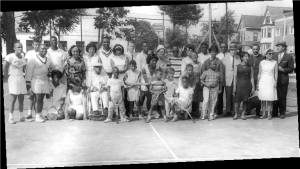
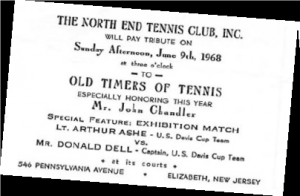
EDGE: What type of tournaments were held at North End?

Art Carrington and Arthur Ashe
AC: We would have our little state ATA tournament, which drew people of color who lived in New Jersey. I would see really high-quality tennis players come in. The first one I remember was a guy by the name of John Mudd, who lived in Orange. He was like 17 years older than me, but we later became doubles partners and he was very instrumental in my life—influential as far as tennis and socially. He was an entrepreneur who owned a nightclub in New York and a nightclub in Asbury Park, where he was from originally. He had a topspin forehand and a kick serve—he opened my eyes up to another level of tennis.
EDGE: Did you have other mentors at the club?
AC: Yes, many. One was Dr. William Hayling, a gynecologist who delivered thousands of babies. He was one of the founders of 100 Black Men along with Jackie Robinson. He grew up with Mayor Dinkins in Trenton. I met African Americans from all over the country at the North End Tennis Club and gradually I began to spread my wings. I would go to these people’s houses, where for instance I remember seeing my first finished basement. I mean, I came from good parents—working parents—but this was a step up, financially and socially speaking. This led me to be introduced to their counterparts in the white world. White doctors, white lawyers, and their kids.
EDGE: Describe the location within the context of Elizabeth back then.
AC: North Avenue was a very commercial strip. At one time, around 1900, it was a leading thoroughfare that went from Elizabeth to Newark. There was a doctor who owned a large house and he had the only double lot, which extended all the way back to the next street, which happened to be the start of the black neighborhood. His family sold the house, but the tennis court was sold to the North End Club.
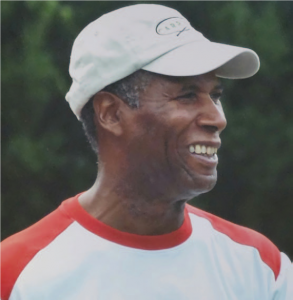 EDGE: What kind of friendships did you forge at the club?
EDGE: What kind of friendships did you forge at the club?
AC: There was a guy name Eddie Eleazer who lived near the club, who was a very good player. We went from fifth grade through Hampton Institute together. When colleges started recruiting me, I would tell them about him, as well as my brother, who was a year behind us and also was very good—he went to Rutgers. Eddie and I graduated from Hampton together and we won all the conference and national black titles together in doubles. There’s nothing like having a comrade, you know what I mean? We were on the same teams together going back to Thomas Jefferson in Elizabeth. He and I and Ron Freeman, an Olympic 400-meter man, formed a partnership that is unbreakable to this day. We all speak several times a week. We used to say, “We are doin’ our thing and movin’ on.” [Laughs].
 EDGE: At the other end of Union County was Shady Rest. In what ways did that differ from the North End Tennis Club?
EDGE: At the other end of Union County was Shady Rest. In what ways did that differ from the North End Tennis Club?
AC: Shady Rest was a country club out in Scotch Plains. That was the number-one country club for black people. The people who built Echo Lake built Shady Rest and sold it to black owners in 1921. It had nine tennis courts, a nine-hole golf course and a large dining hall. It had the same kind of people as North End but was much larger. Shady Rest was the kind of place where you’d go to see Count Basie, Duke Ellington and Sarah Vaughan. Segregation made black entertainers go to places where black people socialized. It was the spot. There was nothing else like Shady Rest in the country.
EDGE: Let’s get back to your coach, Sydney Llewellyn for a moment. He seemed like quite a character. Can you paint a picture for me?
AC: I met him when I was 12. He came in from New York and he was always a real smooth dresser. He had his safari suit on with the safari hat—he was dressed to kill. He was the first tennis “pro” I knew, in that he had the tennis pro look, he had the gear, but he was also very cosmopolitan, a very smooth brother. [Laughs] As young urban kids, we loved to listen to him. He came from Jamaica at about 18 years old to New York. He told us he came to America to be a dancer, a hoofer and whatnot. Dancing was like the rap industry in those days. I learned a tremendous amount from Sydney about life and spirituality and family and manhood. He was a tremendous mentor of mine.
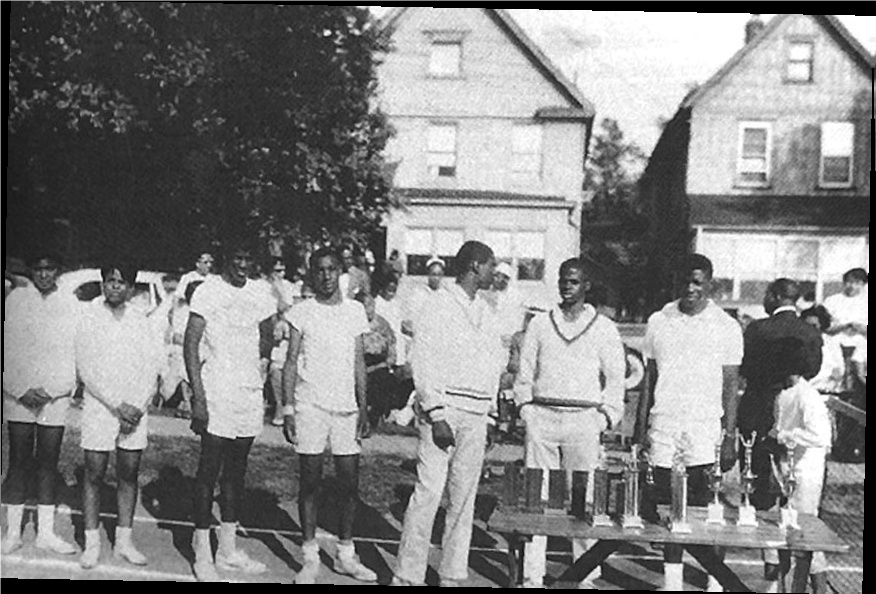 EDGE: What is it that made him special as a tennis coach?
EDGE: What is it that made him special as a tennis coach?
AC: He was a purist as far as his stroke production. So he was like Nick Bollettieri—very fundamental.
EDGE: I worked with Nick on a book, by the way, and it was the most stressful year of my life.
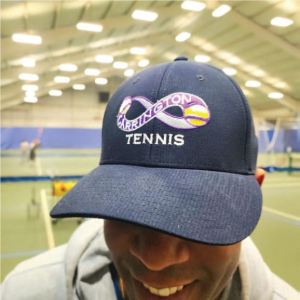 AC: [Laughs] I can imagine that. That’s what I’m saying, because when you don’t have a real tennis background, you just pound them fundamentals, I guess. Actually, Sydney did have tennis in his background from Jamaica.
AC: [Laughs] I can imagine that. That’s what I’m saying, because when you don’t have a real tennis background, you just pound them fundamentals, I guess. Actually, Sydney did have tennis in his background from Jamaica.
He had worked somewhere as a young man and had access to a white tennis club, so I suspect he was introduced to tennis in the proper way.
EDGE: After college, you kind of kept the North End club alive. What was happening at that point?
AC: Starting in the 1960s, some Jewish doctors offered their black colleagues an opportunity to come join their clubs for tennis and golf. It was just enough that we lost our leadership, which kind of just filtered away. In the 1970s, we finally gave up our place in Elizabeth. It’s understandable. Everybody wants better facilities. When I didn’t know anything else other than North End, that was the greatest facility. As my game improved and I competed at other clubs, I realized that there were better places to play. After I graduated from Hampton in 1969, I kept North End open in the summertime to run my tennis academy until 1975.
EDGE: What made you decide after college to get into coaching? What new perspective did you feel you could offer other players?
AC: I liked being independent in terms of the business part. Also, I believed in order to coach, to be a good teacher, you need to be your own best student. You’ve got to gain inspiration in order to pass it on. I’ve always believed in whole-body integration, in purely flowing movement. I use rhythm as the special thing that makes the game flow. This has allowed me to be in tennis all these years with no injuries, no rotator cuff issues. I have a nice-looking game. I move with it and I move in a flow. So I teach people how to move properly and to respect rhythmic cycles and sequences, to understand how the body is supposed to work.
EDGE: Has it become harder to get young people to buy into this?
AC: No, because I use martial arts tools and other tools, including music, that are fun in my teaching. So when students go back out onto the court, they are more coordinated. That’s what you need to do in order to be good. I’m a physical education teacher with tennis as a specialty. I think that’s something that is missing from the game. Kids need to have a foundation, phys-ed-wise, that they can use all their lives.
EDGE: It is a rare thing for historians to be participants in the history they cover. While you were coming up as a player at North End—obviously long before you began researching your book Black Tennis—did you have a chance to interact with some of the pioneers from the early days of the ATA, the great champions like Ora Washington?
AC: Yes, I did. They were older people by then, of course. But you know, there were no books that told their story, no place you could go to learn about them. Even many years later that was the case. You hear about Arthur Ashe, you hear about Althea Gibson, but there is almost nothing about the tennis communities that produced them. If you didn’t have the doctors and lawyers and other professionals—backed up by all these progressive African Americans—at facilities like the North End Tennis Club, you might not have had an Ashe or a Gibson or an Art Carrington. That is why I wrote Black Tennis and archived it the way I did. The story is in the community and that’s what people are missing about places like we had in Elizabeth. During the time when tennis was booming with blacks, we were coming from little neighborhood clubs like North End. Most people don’t know about this. They ask me, “How did you get into tennis?” And I’m like, growing up, I thought tennis was a black game! [Laughs] When I first set my eyes on tennis, it was all black people. There wasn’t anything that told me I’m not supposed to do this, you know what I mean? It’s not like I was aware there was a “white” game. I embraced tennis and the people that went with it.
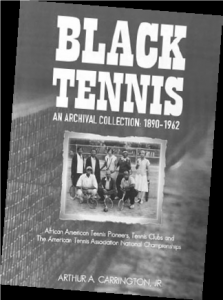 Editor’s Note: Art Carrington was the national singles champion among historically black colleges and universities three times in the 1960s and was the second African-American player after Arthur Ashe to compete in the US Open. In 1972, he played in the ATA singles final, which was the first-ever televised match between black players. In 1973, he was crowned ATA champion. Art says that keeping the history of places like North End alive is “a way of making my own black life matter.” Signed copies of his book Black Tennis can be ordered through The Carrington Tennis Academy, which operates in Amherst and Northampton, MA, at (413) 977-1967.
Editor’s Note: Art Carrington was the national singles champion among historically black colleges and universities three times in the 1960s and was the second African-American player after Arthur Ashe to compete in the US Open. In 1972, he played in the ATA singles final, which was the first-ever televised match between black players. In 1973, he was crowned ATA champion. Art says that keeping the history of places like North End alive is “a way of making my own black life matter.” Signed copies of his book Black Tennis can be ordered through The Carrington Tennis Academy, which operates in Amherst and Northampton, MA, at (413) 977-1967.

